 Sights, sounds, and sentiments from the thirty-four countries that made up the Europe of the time. 
Above is the cover of the July 1967 issue of Continental Film Review, a magazine produced by London based Eurap Publishing, which updated readers on the latest developments in European cinema. This issue focuses on the Netherlands, Yugoslavia, Sweden, Greece, Italy, and the Cannes Film Festival.
Here's an interesting quote from within: An indication of Italy's mammoth production appeared in an Italian trade journal a few weeks back which listed thirty-eight films premiered in the previous few weeks, seventy-six ready to be premiered, twenty being edited, forty-four in production, twenty-one about to start shooting and thirty-one being prepared, making a total of 230 films (including, of course, co-productions).
You probably think that's an enormous number, but last year Italy released 356 films. It's amazing how much there is to see from other countries if you care to look, and that's largely what Continental Film Review was about. We have twenty-plus scans below, and other issues scattered here and there in places around the website.
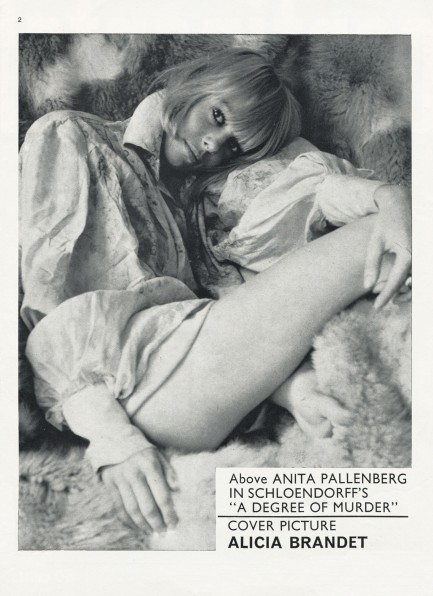                         
 I want this to be good, you two. So take one more look over here to remind yourselves what you're fighting about. 
Last time we read a novel by the globetrotting Ed Lacy, we said afterward we'd travel anywhere with him. In 1961's The Freeloaders, for which you see a beautiful but uncredited cover above, he once again conducts readers to an exotic place—the Côte d'Azur, in the company of a small clan of Americans trying to survive without work visas in and around Nice. Freelance writer Al Cane, the most recent addition to the group, has occasional gigs and makes enough money to live. Ex-boxer/ex-cop/ex-advertising man/constant enigma Charley Martins has savings that keep him in a nice seafront apartment. But painter Gil Fletcher and inveterate schemer Ed Jones struggle daily. The women within the group are diverse. Charley's girlfriend Pascale is young, beautiful, and precocious; Gil's partner Simone is opportunistic and fickle; Ed's girlfriend Daniele is industrious and kind.
Eventually, Gil, desperate to stay in Nice and in need of money for he and Daniele, cooks up a foolproof robbery scheme. But to quote Mickey Rourke in Body Heat, "Any time you try a decent crime, you got fifty ways you're gonna fuck up. If you think of twenty-five of them, then you're a genius." Gil is no genius. The rest of the story deals with the aftermath of the crime on the Nice guys, the unraveling of the mystery of who the mysterious Charley really is, and Al's growing lust toward Pascale. As with other Lacy novels, the flavor is as important as the plot, and he dishes up the South of France (with sides of Italy) in satisfying fashion. There are always a few nits to pick with him. Any time you write a novel there are at least fifty ways to fuck up. Lacy is no genius, but he always entertains. That's travail numéro un.
 If you let yourself be free what amazing things you'll see. 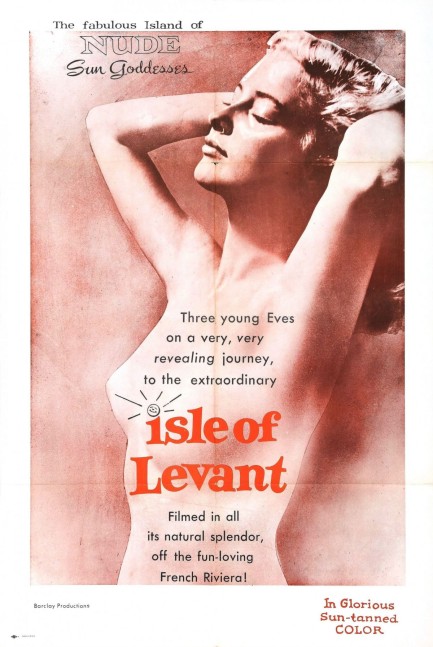
Nudism or naturism is yet another staple of mid-century publishing. Numerous magazines were devoted to the practice, and many novels we've read, such as Marriage Can Wait, Murder Doll, High Red for Dead, and of course, the immortal Nudist Camp, feature nudism. It's also featured in some pretty fun movies, such as 1962's Blaze Starr Goes Nudist. So when we saw this poster for Isle of Levant, one of the seminal nudism movies of the 1950s, we decided to have a look. The film was made by Swiss director Werner Kunz and originally titled Lockender Süden. In its English language version it's professorially narrated by E.V.H. Emmett. The story told is about a trio of young Danish women and their dog who take a road trip through Germany, Switzerland, and France to arrive in the Côte d'Azur and get naked on Île de Levant. It's largely a travelogue, but it's also pretty interesting from purely historical and architectural perspectives. Aided by the familiar visual of a crawling line on a map, you see the sights as the trio passes through Hamburg, the Rhine Valley, Rottenberg, Zurich, the Rhône Valley, Avignon, Cannes, Nice, Saint-Tropez, and Le Lavandou, all before the era of modern mass tourism, in a classic Fiat 600 Multipla, with its rear engine and backward front doors.
As for the nudism, Kunz makes you wait for it. About forty minutes into the sixty-eight minute exercise the girls hit the island and their clothes hit the sand. At first, many people wear g-strings, but later there's nothing. As is typical for such films, the nudists are the best-looking examples from far and wide. Activities range from volleyball to hiking to sketching to snorkeling to boating, but as this is a lifestyle film, there's no sex nor hint of it. Because nudism isn't—and wasn't then—considered sexual by its practitioners, there are a few brief shots of naked children. We live in a country where naked children on beaches are not a strange sight and we pay them little mind, but in terms of filmed reality, this is where things acquire a double layer. Selling films of naked children changes everything. Though these nudism flicks were ostensibly educational, and the nudists themselves agreed to appear as a way demonstrating the advantages of their lifestyle, a large percentage of the actual consumers of the movies—surely—got off on them. And for a small subset, thence, nude children.
In a sense, the nudists of the era, despite the purity of their beliefs, were exploited by filmmakers, who knew—again, surely—that the money that flowed in was from seekers of knowledge about nudism and seekers of boners over naked women and men. As for pedophiles, though they were a segment of society that were basically never thought about by the populace at large back then, we suspect the filmmakers were aware of them. In any case, nobody is unaware today, which is why those shots now stand out in neon. But if you wear your shiny happy 1950s glasses, Isle of Levant is worth a gander. It's a historical curiosity, and one that made us nostalgic for an era in which we never lived. Because they were uncredited, we'll never know who the trio of roadtrippers were, but we had an overwhelming sense of time passed and innocence lost watching them. And we thought: To have made that journey with them from Denmark through the Rhine Valley to the idyllic Côte d'Azur would have been so very fun.
    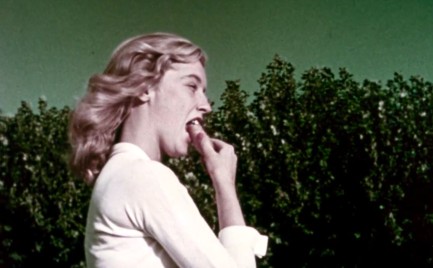   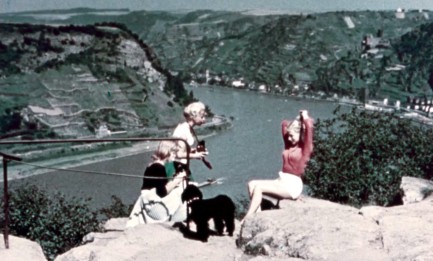   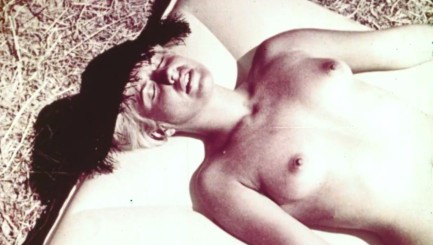 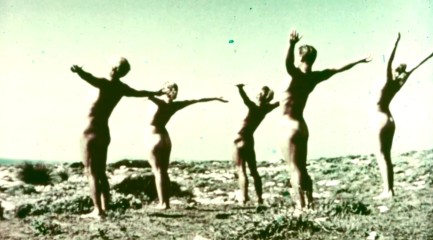 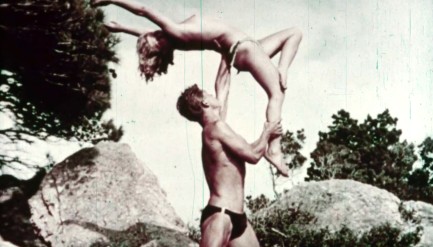 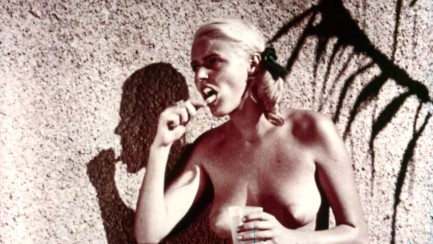 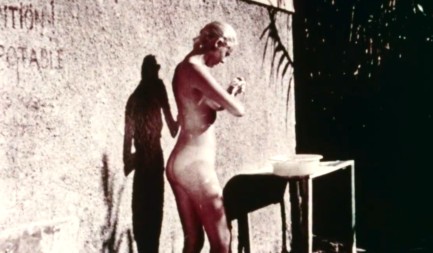 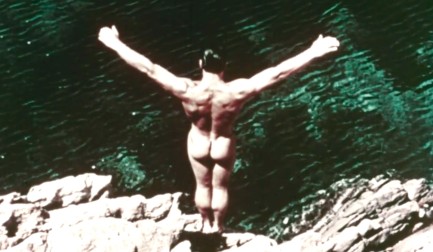 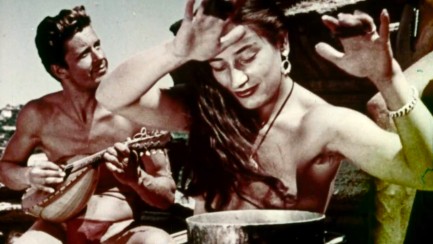 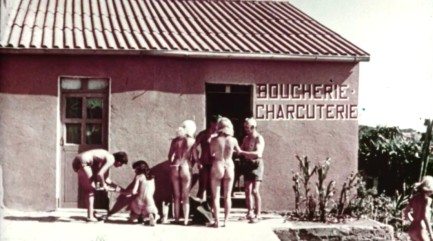 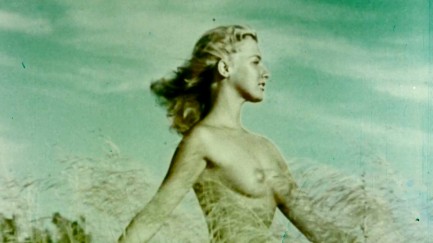 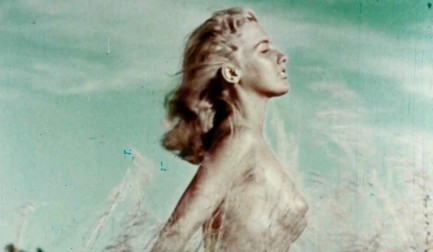
 Lindberg unveils more than just her movie for the Cannes press corps. 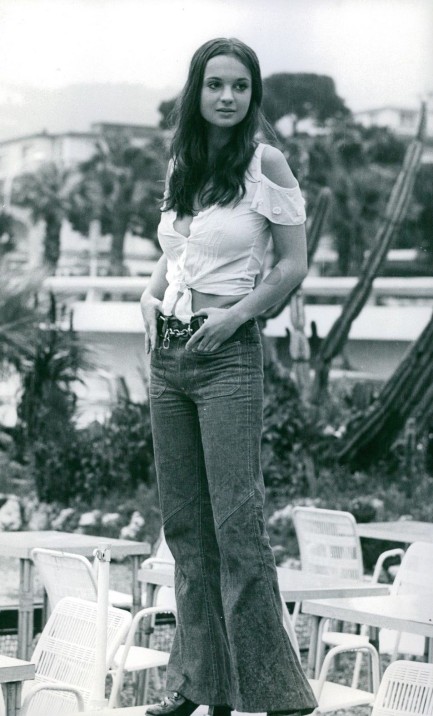
The above image shot today in 1971 shows Swedish star Christina Lindberg in Cannes, France, where she was promoting her movie Exponerad at the Cannes Film Festival. She was also at the prestigious event in 1973 to promote Thriller - en grym film, aka Thriller: A Cruel Picture, so you have to give her production companies Olympic Film and BAV points for effort, even though Lindberg's movies are just arthouse sleaze when boiled down to their essence. And when your movies are not of particular merit what better way to bring attention to them than with random nudity? Shedding clothing was a go-to gimmick for Cannes starlets back when the line between mainstream and erotic film was blurrier than today.
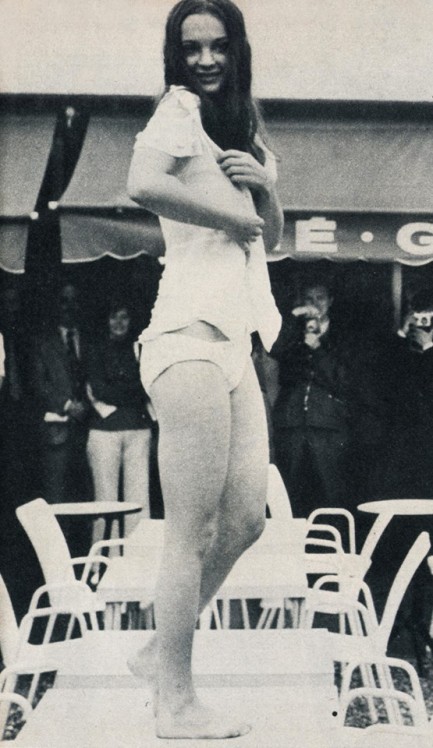 In the first photo Lindberg is on the patio of a Cannes bar, and from her perch atop a table she stripped off everything except her panties while dozens of photographer captured her likeness and bystanders gawped at the spectacle. You can see some of assembled press in the fuzzy reverse angle at right. A bit later, on the terrace of the Majestic Hotel where she was staying, her clothes hit the tiles again, as you see below. In the first photo Lindberg is on the patio of a Cannes bar, and from her perch atop a table she stripped off everything except her panties while dozens of photographer captured her likeness and bystanders gawped at the spectacle. You can see some of assembled press in the fuzzy reverse angle at right. A bit later, on the terrace of the Majestic Hotel where she was staying, her clothes hit the tiles again, as you see below.
She wasn't remotely finished. Here's her memory of a publicity stunt that set Cannes ablaze: “I was going to meet the press out on a pier over the water. After having signed about a thousand invitations, which were given out to select people, I was lowered down from a rented helicopter to the pier topless. There were hundreds of photographers.”
We find it amazing that so few photos of such an event seem to survive today. There must have been thousands of frames shot of that helicopter stunt. Lindberg's recollection of so many photographers shows you the sheer volume of imagery that's lost to time. Luckily, she's well documented anyway thanks to the photo sessions she made for various international magazines and her 1973 photo book. A few of our favorites are here, here, and here. She'll return to Pulp Intl. soon.
 
 Is there really such a thing as too much? 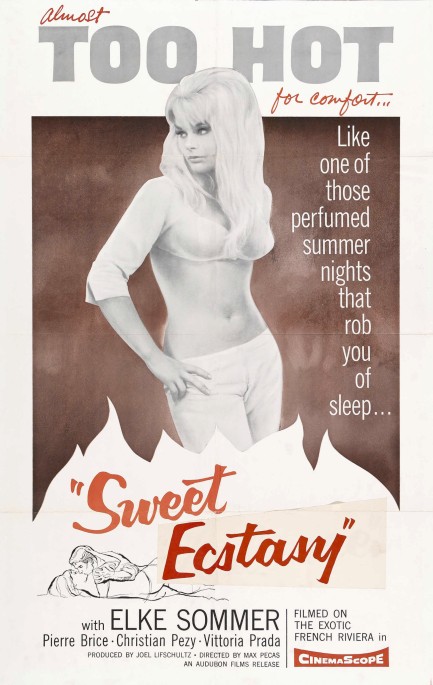
Elke Sommer front and center on a vintage poster claiming she's “almost too hot”? Sign us up. Sweet Ecstasy was originally made in France as Douce Violence—“sweet violence”—and fits loosely into a cycle of films characterized as nouvelle vague, or the French new wave. Director Max Pécas, however wasn't a new wave director. He was better known for his work at the forefront of the cinéma Z style, also known as the nanar sub-genre, films loosely equivalent, we gather, to eroticized b-movies, meaning sex and stupidity. Pécas is also remembered for a trilogy of 1970s Saint-Tropez erotic comedies. But for Douce Violence he's an art director, trying to make a significant statement in the same broad category as La dolce vita or À bout de souffle, aka Breathless.
To that end, what you get here is a group of idle twenty-somethings for whom entitled boredom is the order of the day, as they rip around the French Riviera near and within Cannes, seeking thrills and not caring about the future. When Olivier (Christian Pezey) finds himself drawn into this clan of troublemakers living on their parents' money, their leader Maddy (Pierre Brice) enlists his own girlfriend to be the soft edge of the wedge in a scheme to corrupt the newcomer. It's for Olivier's own good, you see, because he's too bourgeois.
The girlfriend is Sommer, playing a character also named Elke, and she's in vamp mode here, which means cat-eyed make-up and cumulonimbus hair, as she taunts and teases poor Olivier in her efforts to make him into a fellow disaffected youth. Is she too hot? No. Elke is always just hot enough. She and her pals go water-skiing (really Elke in some of the shots), swimming, boating, driving, and most of all, partying. They question convention, conformity, society, mortality, and all the rest. Like other movies of this type, there isn't much plot. Also as in similar films, an event galvanizes and changes the group—or seems as though it might.
The main attraction in the film is Elke, and she delivers what early ’60s audiences wanted—an envelope pushing performance amidst a growing wave of censorship-destroying movies. Like Bardot and others, Sommer shows a lot of skin, and almost—almost—goes topless. Though it's supposed to be gauche to say so about a woman these days (but we don't care, because sex is why we're all here, and it's ultimately all that matters, despite modern attempts to obfuscate it, hide it, police it, and shame it), Elke's very stimulating. And she doesn't even look her best here, due to the crazy make-up and hair. As a final note, we suspect the movie was censored in the U.S. to remove some revealing bikini scenes, some shots of Elke's asscrack, a bare breast caress by a male character, and (probably) some or all of a sweaty, open-shirted dance by a black character. The poster certainly was censored—no doubt about that. The word “ecstasy” was placed to cover the word “violence.” You can just see it if you squint. So the movie's title was set to be literally translated, but that was deemed too much for Americans—or at least some Americans (southerners, we suppose). Douce Violence opened in France and Belgium in early 1962, and reached the U.S. today the same year. 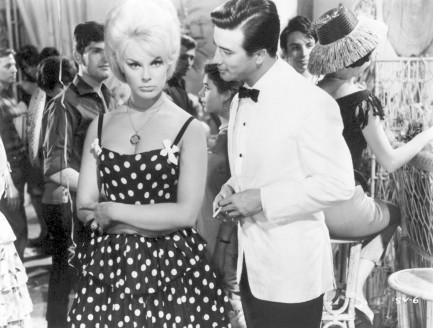 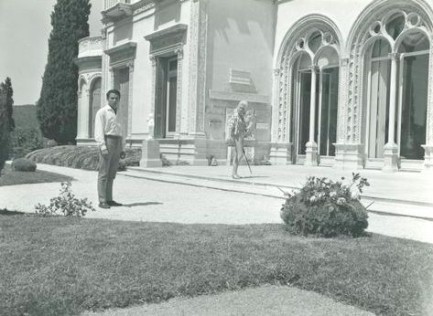 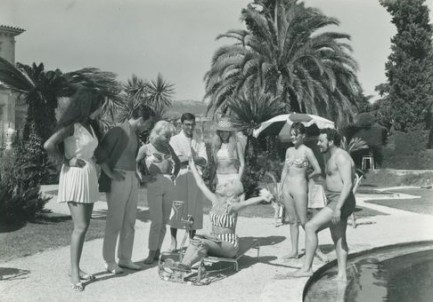  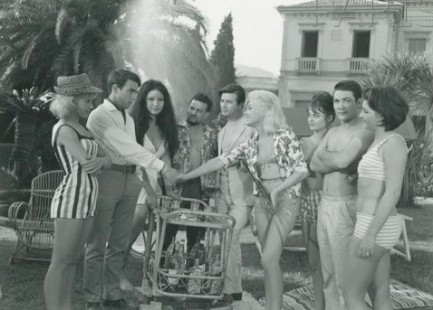 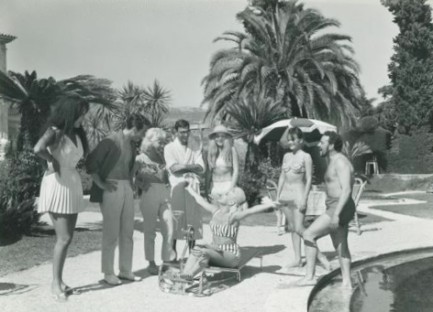 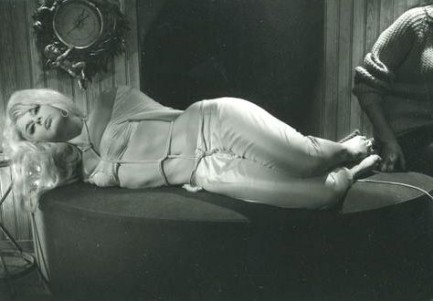 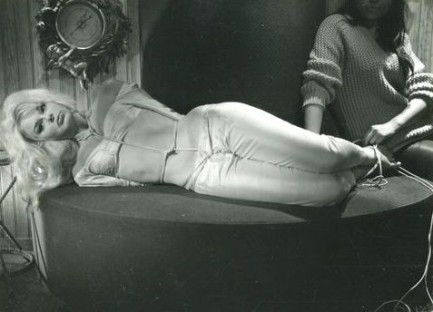 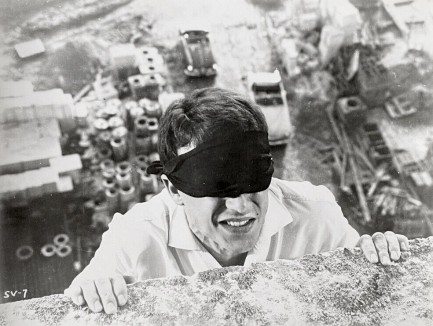 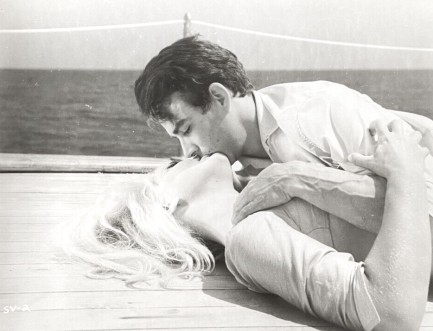 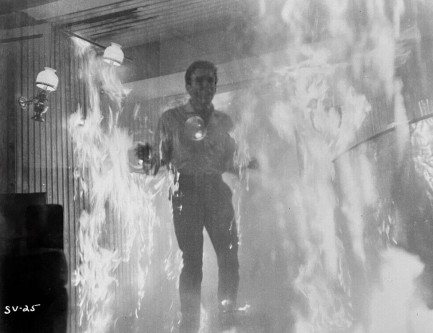  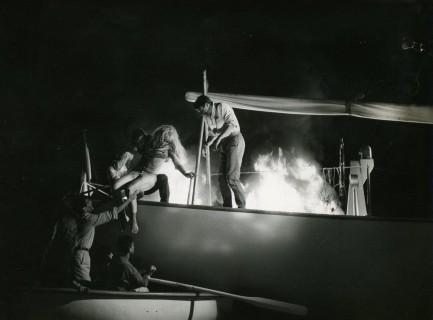 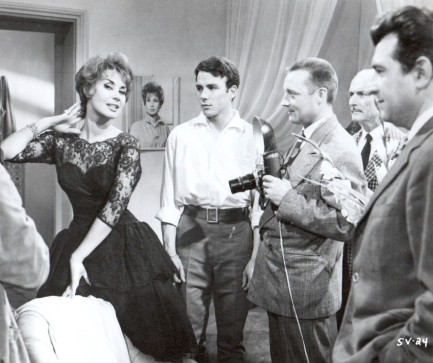 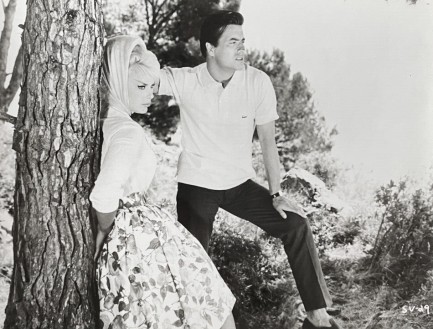 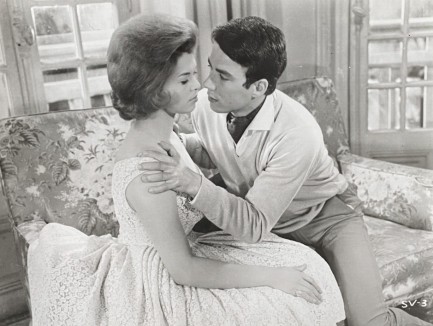 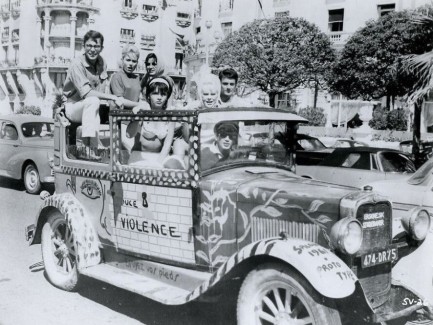 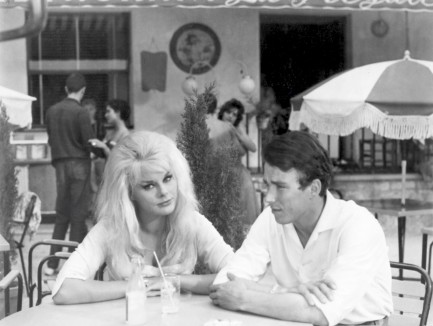 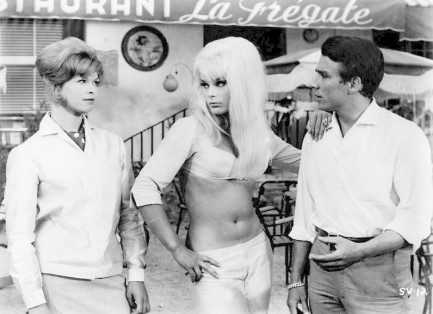 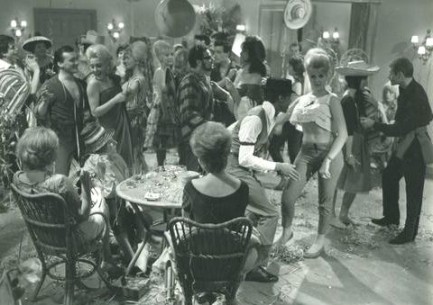 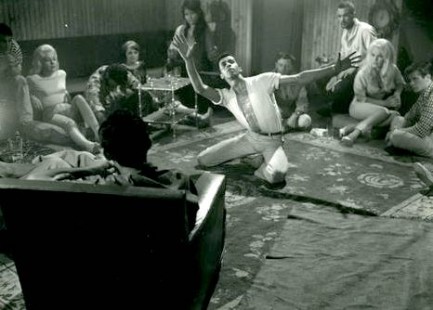 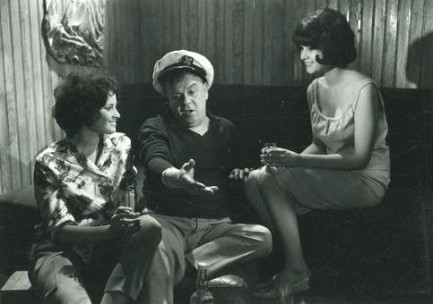  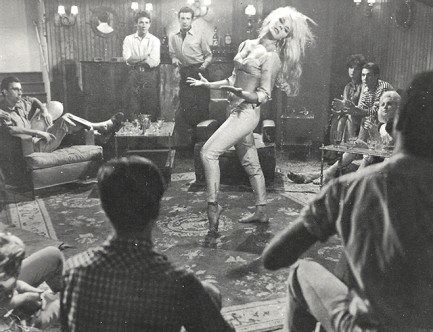 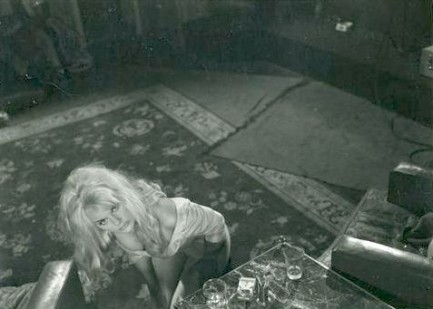 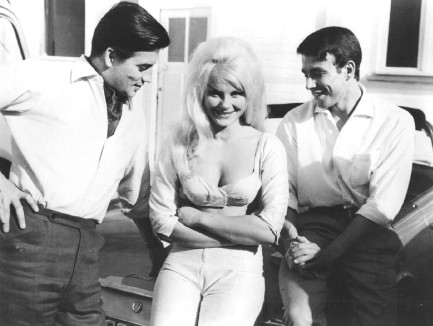 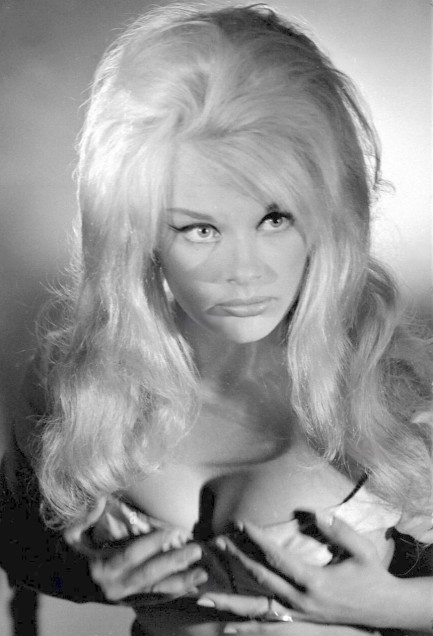 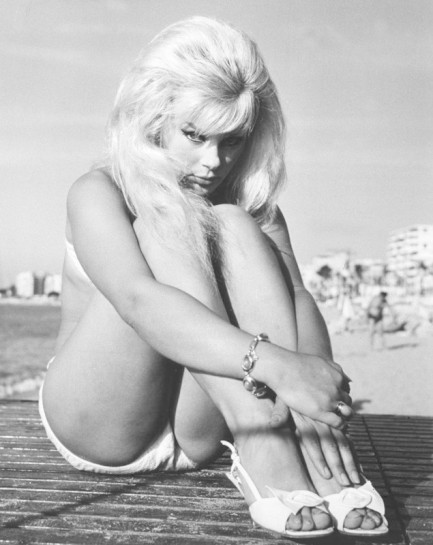
 If a boxer falls when nobody hits him is it still a knockout? 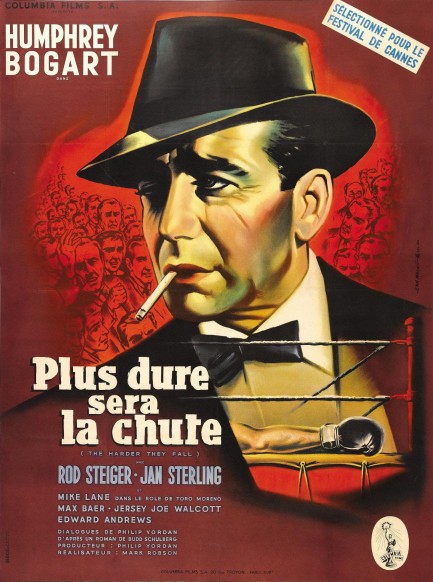
We've been neglecting French promo art lately, so here'a a little something—a poster for Plus dure sera la chute, which is better known as The Harder They Fall. This was painted by Jean Mascii, whose work we last saw several years ago when we talked about the 1960 thriller Plein soleil. We recommend having a look at that to get a better sense of Mascii's skill. He created a very interesting portrait of Humphrey Bogart for this effort. This was Bogart's last movie. He filmed it while gravely ill, having been diagnosed with esophageal cancer, but did his work in legendary style, a true professional, working long hours, shooting retakes, and generally doing all he could to prevent his condition from affecting the production.
Bogart plays a struggling sports writer hired by shady fight promoter Rod Steiger to be the press agent for his new discovery—a gigantic but glass-jawed carnival strongman from Argentina named Toro Moreno. Steiger wants Bogart to sell Toro as the next great heavyweight contender, but in order to do so they need to send him on a bum-of-the-month tour to knock out a series of hapless opponents paid to take dives. After Toro has been built up in the press as the second coming of the heavyweight division, Steiger plans to make a bundle with a match against the champ, played by Max Baer. Bogart signs on for this ride because after all his work in the newspaper business he has nothing, and wants to finally make real money. But it could cost his reputation, and because Toro has no clue the fights he's winning are fixed, the scheme can only end with the poor overconfident dupe slaughtered by the champ.
Steiger would win an Academy Award in 1967 for In The Heat of the Night, and here, more than a decade earlier, you can see that achievement as almost inevitable as you watch him dominate the screen. He's simply great in this, and Bogart gives an excellent performance too, failing physically but soldiering onward, using that world weary mug of his to impart a lifetime's worth of fatigue and disappointment. The movie also features Jan Sterling. We had no idea she'd gone in for rhinoplasty, and at first weren't positive it was her. It is though, and after writing just recently how gorgeous she was we're sad she didn't see her own perfection and instead chose to go under the surgeon's knife. But her body her choice. She's good as always, here playing Bogart's conscience, trying to keep him from sliding down the slippery slope to amorality.
There's another person who should be mentioned—Mike Lane as the lumbering Toro Moreno. This was his debut role, and you'd think there weren't many more parts out there for a guy standing 6'8”, but surprisingly he accumulated almost seventy acting credits, almost all on television, where he appeared in shows of every type, from Gunsmoke to Get Smart. Obviously, any vintage boxing movie involves mimetic acting, and the fighting here isn't realistic—quantum leaps in how to convincingly portray ring scenes came later—but they serve their purpose. And for boxing realists, the movie gets extra credit due to the presence of both Baer and Jersey Joe Walcott. The Harder They Fall opened in March 1956, and had its French premiere today at the 1956 Cannes Film Festival. 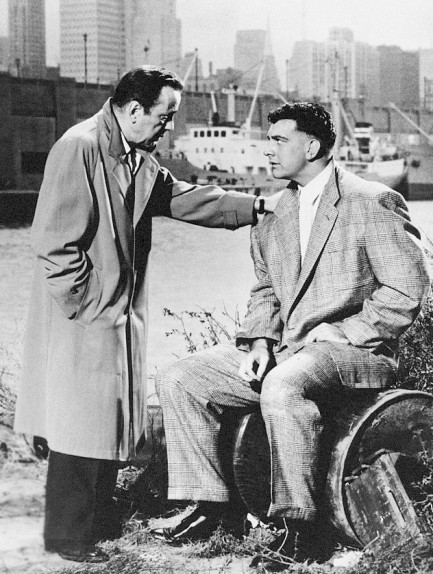 Fine, Toro, you're huge. Massive. Enormous. But you need to learn how to box or the champ is going to crush your face like a graham cracker. Fine, Toro, you're huge. Massive. Enormous. But you need to learn how to box or the champ is going to crush your face like a graham cracker.
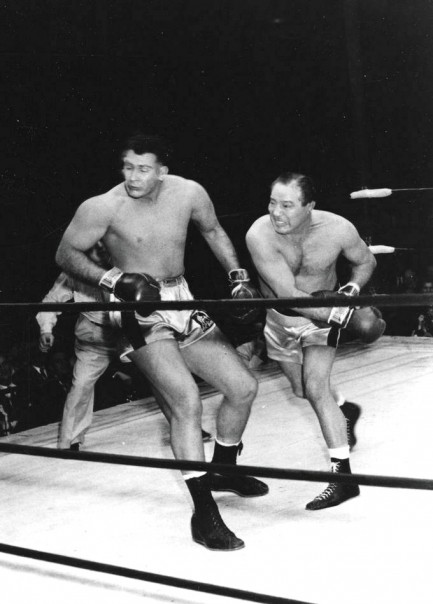 Hi, champ! Before we start, I just want to say I'm probably your biggest admir— Hi, champ! Before we start, I just want to say I'm probably your biggest admir—
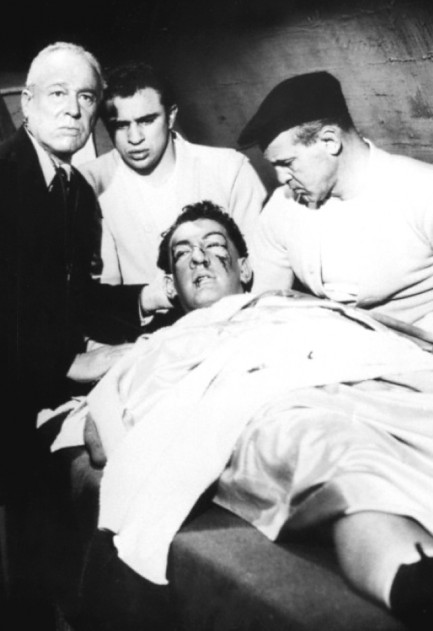 I thought that whole graham cracker speech was just Bogie being colorful. I thought that whole graham cracker speech was just Bogie being colorful.
 David Dodge explains how to travel like a boss even if you aren't. 
Is The Poor Man's Guide to Europe pulp? Think of it as pulp adjacent. David Dodge was one of the better crafters of crime and adventure fiction during the mid-century, so when we learned that he had written travel guides we knew they were must-reads. His novels were often outward looking. To Catch a Thief was set on the French Riviera; Plunder of the Sun, Mexico; The Long Escape, several Latin American countries including Chile and Peru. And Dodge's first travel book How Green Was My Father dealt with Mexico and Guatemala. But Europe is the subject here, and accompanied by Irv Koons illustrations, Dodge mines nuggets of valuable info from his continental experience for Americans who cross the pond. As this is a book about getting by on a budget, much of the info has to do with currency trading, a reduced concern these days, but the ins and outs of swapping cash make for some interesting insights into the various countries involved, and Dodge is clever at weaving travel anecdotes while keeping his narrative money focused. Example:
Night was falling with that dull thudding sound it makes when you don't know where you are going to sleep. By bribing the concierge I got three beds at a “first class” hotel across the street. It was terrible—overcrowded, noisy, and operated according to the old army slogan: Don't you know there's a war on, buddy? I got out early the next morning, walked three blocks to the center of town toward the Via Vittorio Veneto, and landed two bedrooms, a sitting room, a bathroom, and a balcony in a clean, old-fashioned, superbly operated Italian albergo with a wonderful cook and waiters who caught dropped napkins before they hit the floor. The patrono, who spoke six languages, took Elva and me to the opera as his guests three nights later while his wife babysat with Kendal, and the overall charge was 8,500 lira a day, about $13, all meals and table wine included.
And that's pretty much what travel is about for us—seizing victory from the jaws of defeat. Other anecdotes had us searching for confirmation, they were so hard to believe. For example, was it really the trend in 1953 for some women on the Cotê d'Azur to wear a cache-sexe? Dodge says it was. It's central to a tale about his friend crashing a rental car into a palm tree after seeing two cache-sexe clad women on the Croisette in Cannes. In case you don't know, this cache-sexe was a thong bottom and stick-on breast coverings that made women look almost nude when viewed from the rear. We have topless and occasionally unclothed women on our beach, but still, we'd give a lot to see something like what Dodge describes, considering these women were not on the beach, but ambling down the street. We once saw two women in bikinis who had wandered several blocks from our beach to ponder the outside of the local cathedral, and that visual incongruity stuck with us for weeks. The cache-sexe must have absolutely scandalized people. And thrilled them too. Maybe that's why Dodge wrote a sequel guidebook focused entirely on the south of France with the tongue-in-cheek title The Rich Man's Guide to the Riviera. We bought that one too. Stay tuned.
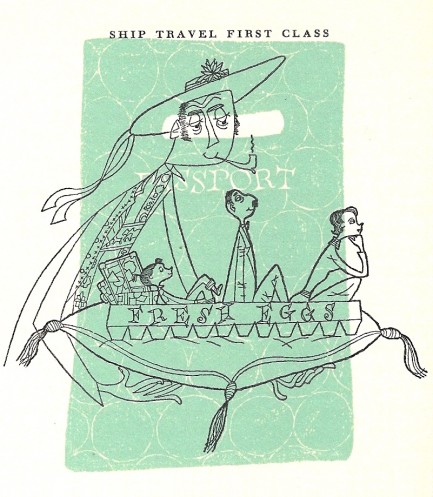 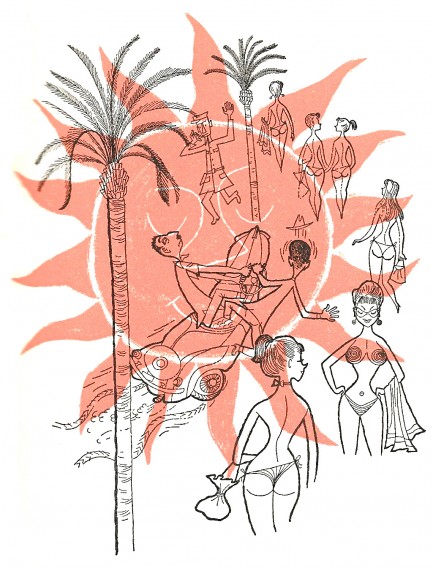 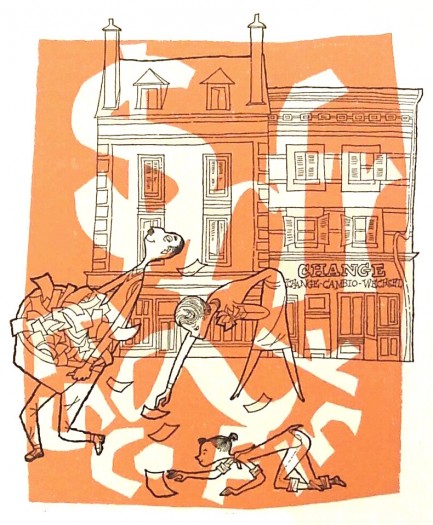 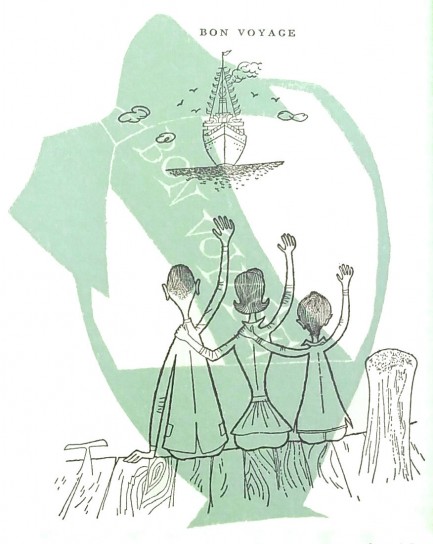 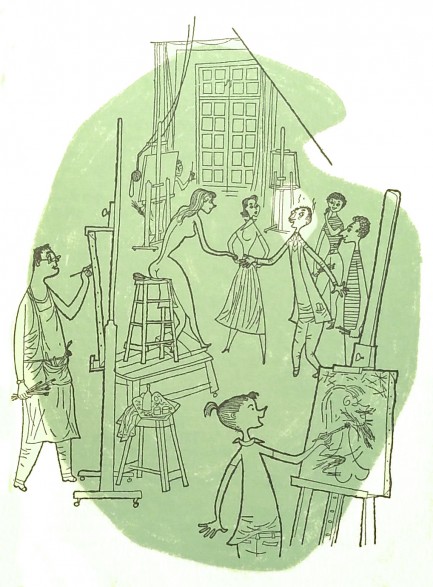
 Mitchum packs everything he needs for traveling except his sleuthing hat. 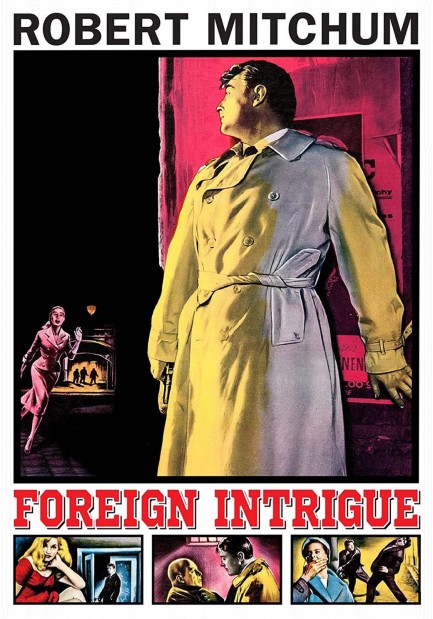
This beautiful poster for the Robert Mitchum thriller Foreign Intrigue is yet another framable delight from the golden age of Hollywood. Wikipedia calls this movie a film noir, but genre designations are often wrong there and on IMDB. This is actually a spy movie, often light in tone, sort of like the later films Charade and Arabesque. Mitchum is an American in Paris working as a press agent for a reclusive one percenter. When his employer dies of a heart attack, Mitchum comes to believe there was more to the death than a blown ventricle. He follows a trail of clues from the French Riviera to Vienna and Stockholm, which is where the foreign part of Foreign Intrigue comes in. The intrigue part? Well, that never fully develops. In fact, the movie falls back on the cliché of having the villains explain their plot to the protagonist. It has to do with money, blackmail, traitors, and Hitler. Trust us, it's not as interesting as it sounds. Compounding the narrative problems is a dopey soundtrack and a Mitchum who's short on charm here. The flirtations between him and Swedish love interest Ingrid Thulin are solid wood. She went on to win Best Actress at the 1958 Cannes Film Festival, which goes to show that half of acting is screenwriting. Are there any saving graces to Foreign Intrigue? Of course. It's well shot, atmospheric, cast with international actors and their wonderful accents, and is a nice travelogue, encompassing Mediterranean villas, Vienna backstreets, and Swedish lakes, all in lush Eastmancolor. And Mitchum is watchable even in a film that mostly wastes his considerable star power. Intrigued? Then go for it. Foreign Intrigue premiered today in 1956. 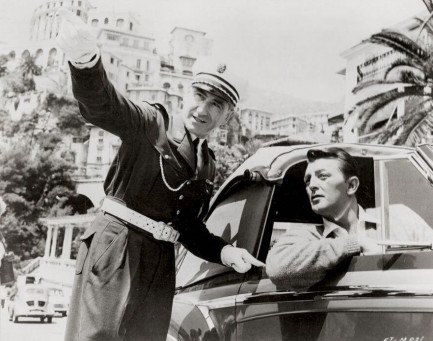 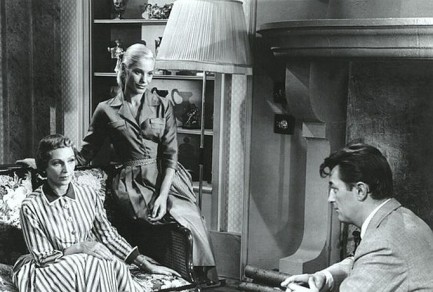 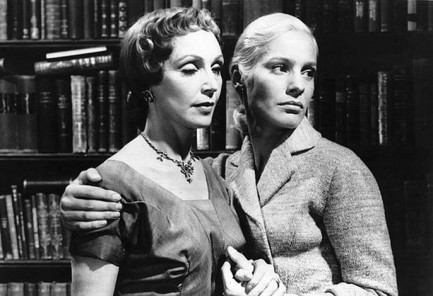 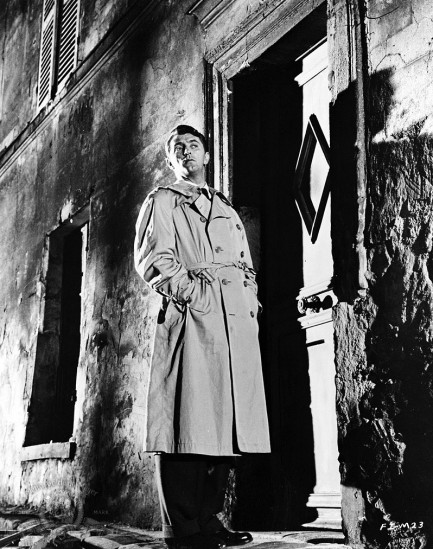 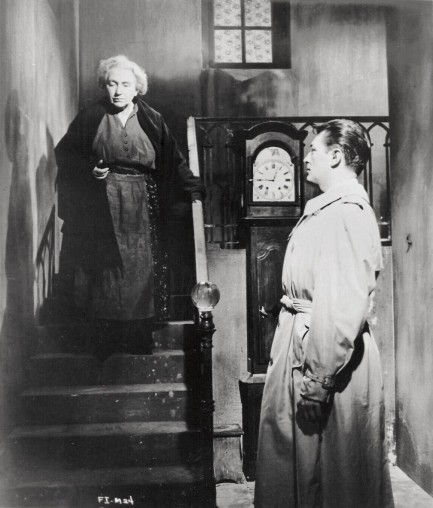 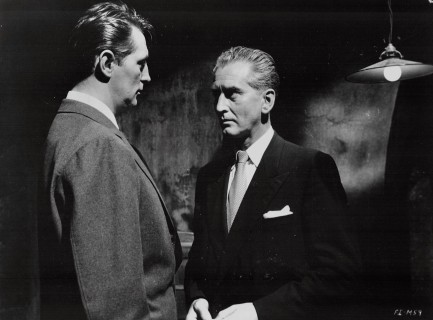 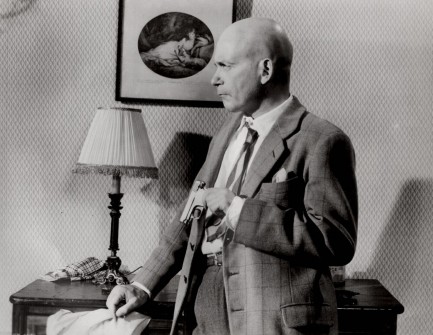 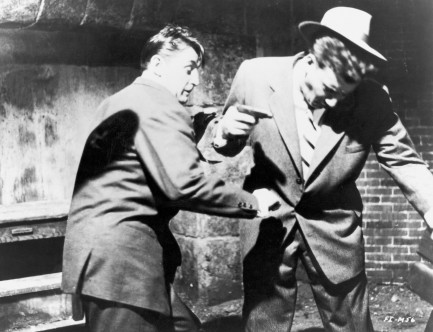 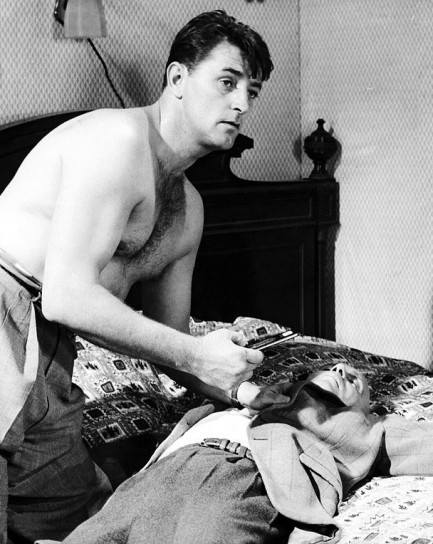  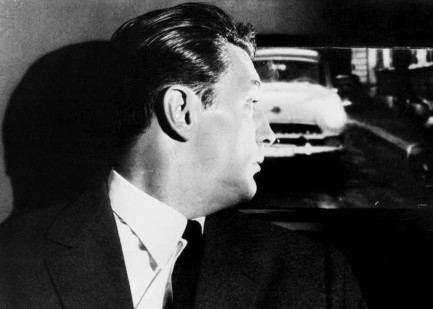 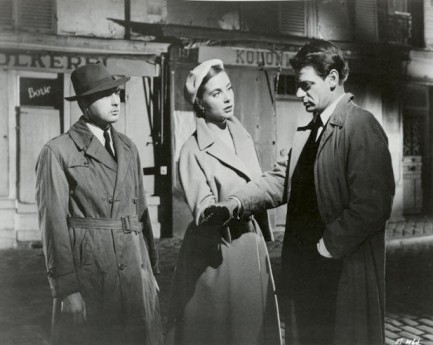 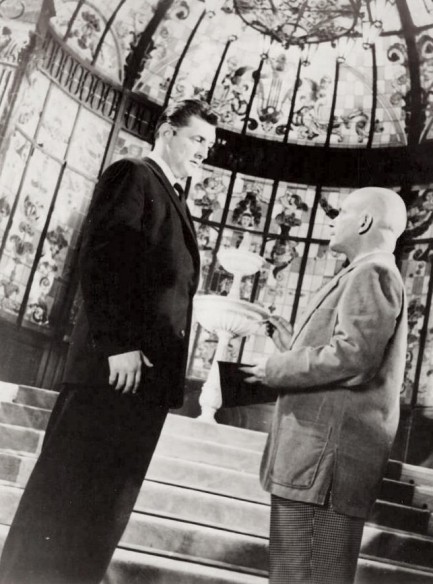 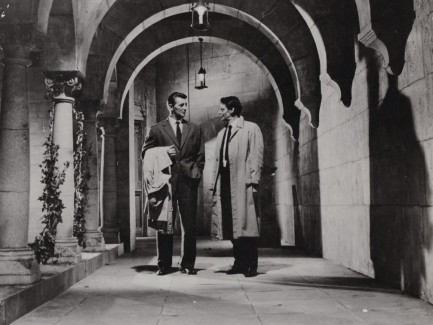 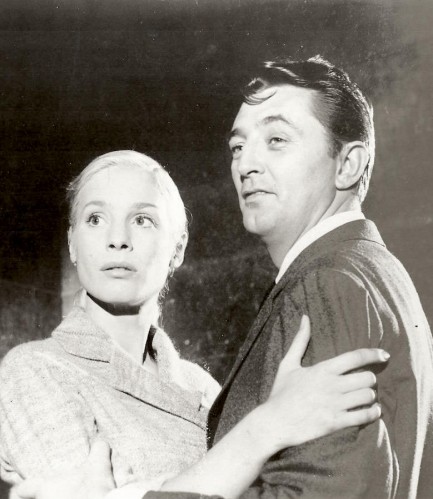 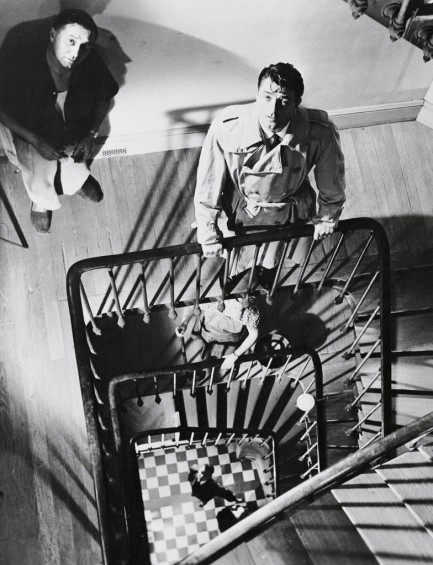
 Cardinali sizzles in the south of France. 
Our sun is categorized as a G2V type star, and in this blinding photo Italian actress Nuccia Cardinali—sometimes Cardinale, occasionally Karen Carter—is too G2V to be true as she poses for a shot in Cannes, France. Her cinematic career was scant, consisting of a dozen or so films. But that's okay—she personifies summer, surf, sand, and all things good and glowing in this image. It appeared as a centerfold in Ciné-Revue magazine in 1970.
 Hitchcock says no festival for you this year! 
The 73rd edition of the Festival de Cannes, aka the Cannes Film Festival, would have kicked off today in the south of France, but was cancelled a while back. It's just one of a wave of event cancellations that will cascade through the year. Festivals as diverse as Burning Man and San Fermin, aka the Running of the Bulls, have also been shelved. But getting back to Cannes, we thought this would be a good moment to commemorate past fests with some historical photos. Above you see Alfred Hitchcock on a boat with the town in the background, in 1972, and below are about fifty pix from the 1940s through 1970s, documenting various iconic moments, and a few quieter ones. Maybe the Cannes Film Festival will back next year, maybe not. At this point, predicting anything is an exercise in futility. But at least we'll always have the memories.  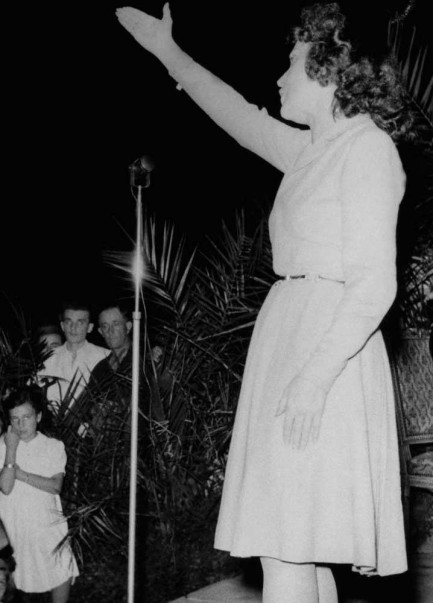 Edith Piaf sings on the terrace of the Carlton Hotel on the iconic Boulevard de la Croisette at the first Festival de Cannes to be held under that name, in 1946. Back then the event took place in September and October, but would shift to May a bit later. Edith Piaf sings on the terrace of the Carlton Hotel on the iconic Boulevard de la Croisette at the first Festival de Cannes to be held under that name, in 1946. Back then the event took place in September and October, but would shift to May a bit later.
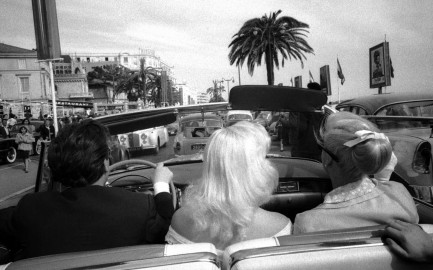 Diana Dors and Ginger Rogers arrive at the fest the only way anyone should—breezing along the beachfront in a convertible, in 1956, with an unknown driver. Diana Dors and Ginger Rogers arrive at the fest the only way anyone should—breezing along the beachfront in a convertible, in 1956, with an unknown driver.
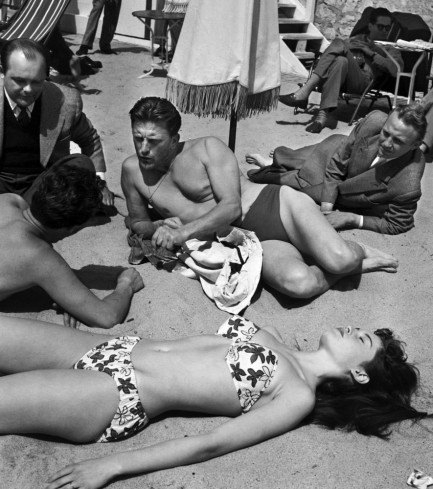 Kirk Douglas holds court on the beach in 1953, and Brigitte Bardot soaks up rays in the foreground. Kirk Douglas holds court on the beach in 1953, and Brigitte Bardot soaks up rays in the foreground.
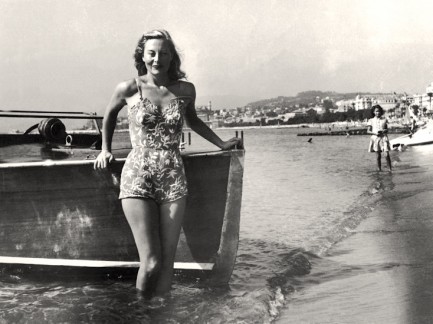 Michele Morgan poses at the first Festival in 1946. Photo ops of this sort were essential sources of publicity for stars, and would soon become opportunities for non-stars seeking to be discovered. Michele Morgan poses at the first Festival in 1946. Photo ops of this sort were essential sources of publicity for stars, and would soon become opportunities for non-stars seeking to be discovered.
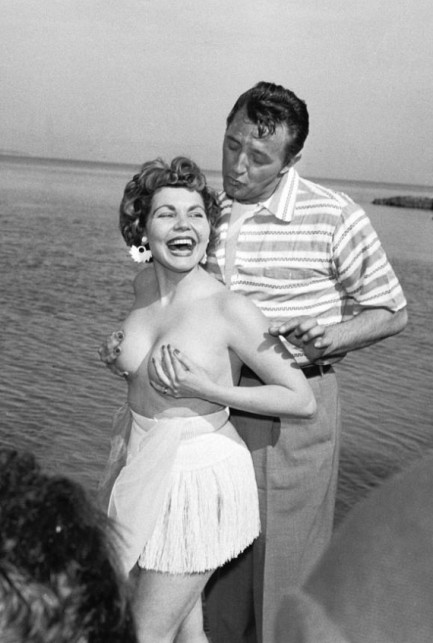 Case in point. Robert Mitchum poses with actress Simone Sylva in 1954. Sylva was allegedly not supposed to be there, but shucked her top and photo-bombed Douglas in an attempt to raise her profile. It didn't work. She made only a couple of credited movie appearances after her topless stunt. Case in point. Robert Mitchum poses with actress Simone Sylva in 1954. Sylva was allegedly not supposed to be there, but shucked her top and photo-bombed Douglas in an attempt to raise her profile. It didn't work. She made only a couple of credited movie appearances after her topless stunt.
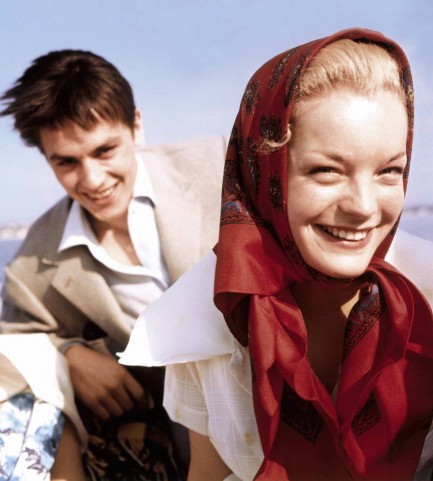 Romy Schneider and Alain Delon at the 1959 fest. Romy Schneider and Alain Delon at the 1959 fest.
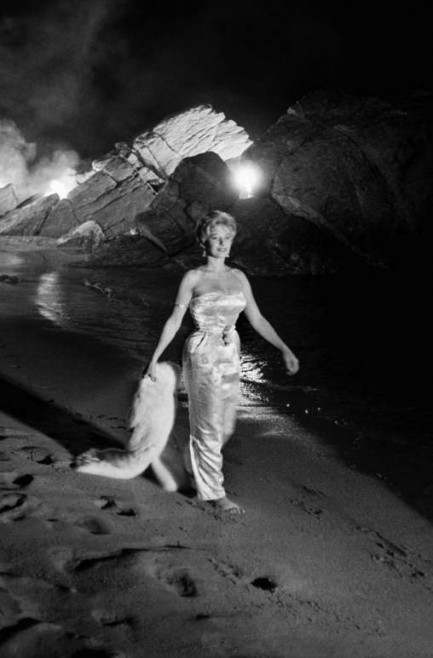 An unidentified model or actress poses in the style of Anita Ekberg from La dolce vita in 1960. This looks like it was shot at Plage du Midi, which is a beach located a little ways west of the Cannes town center. An unidentified model or actress poses in the style of Anita Ekberg from La dolce vita in 1960. This looks like it was shot at Plage du Midi, which is a beach located a little ways west of the Cannes town center. 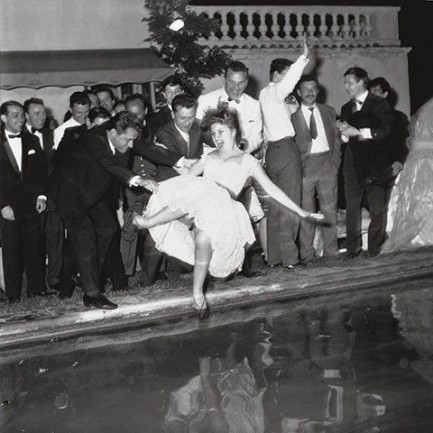 A unidentified partygoer is tossed into a swimming pool after La Dolce Vita won the the 1960 Palme d’Or. The Festival is almost as well known for legendary parties as for legendary film premieres. A unidentified partygoer is tossed into a swimming pool after La Dolce Vita won the the 1960 Palme d’Or. The Festival is almost as well known for legendary parties as for legendary film premieres.
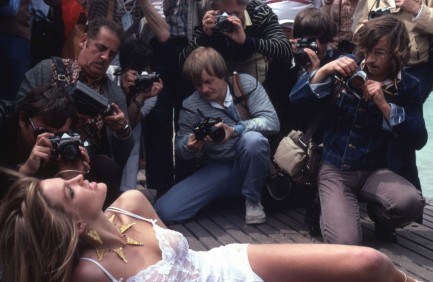 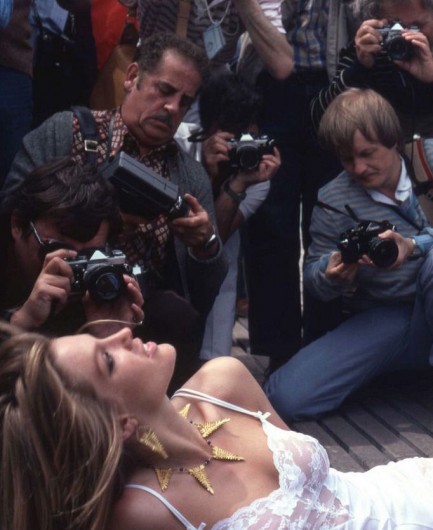 Another unidentified model or actress poses on the boardwalk in 1979. Generally, you don't have to be known to draw a crowd of photographers—you just have to be nearly bare. She's wearing lingerie, so that explains the interest, though this is modest garb for a Cannes publicity stunt. It's never a surprise to see a headline-seeking film hopeful strip all the way down to a string ficelle féminin, or thong, which is the limit of what is legal in Cannes Another unidentified model or actress poses on the boardwalk in 1979. Generally, you don't have to be known to draw a crowd of photographers—you just have to be nearly bare. She's wearing lingerie, so that explains the interest, though this is modest garb for a Cannes publicity stunt. It's never a surprise to see a headline-seeking film hopeful strip all the way down to a string ficelle féminin, or thong, which is the limit of what is legal in Cannes
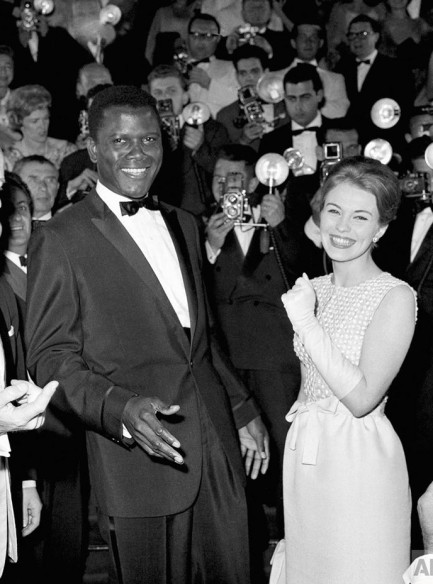 Sidney Poitier and Jean Seberg have a laugh in 1961. This was the year Poitier's flick Paris Blues was released, so it's possible he had jetted down from the capital for the Festival. Sidney Poitier and Jean Seberg have a laugh in 1961. This was the year Poitier's flick Paris Blues was released, so it's possible he had jetted down from the capital for the Festival.
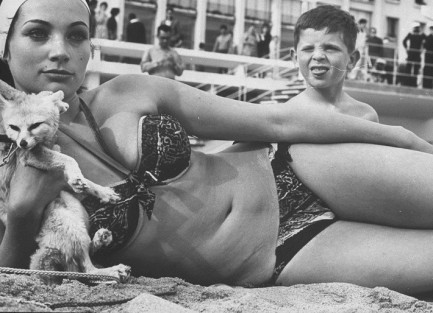 Philomène Toulouse relaxes on the sand in 1962 while a boy practices the classic French look of disgust he'll be using the rest of his life. Philomène Toulouse relaxes on the sand in 1962 while a boy practices the classic French look of disgust he'll be using the rest of his life.  Actor Bernard Blier, 1975. Actor Bernard Blier, 1975. 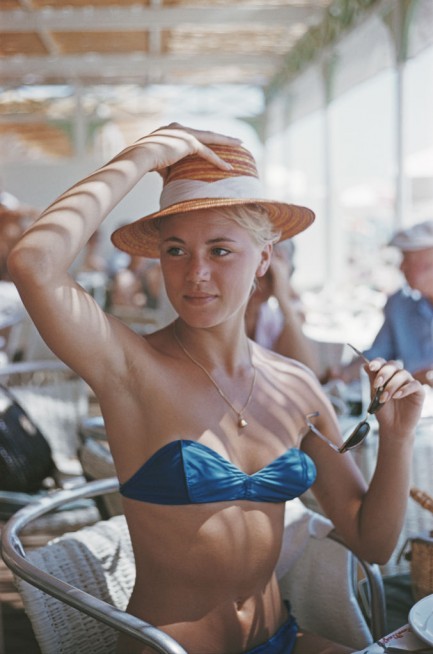 An unidentified bikini wearer boldly enjoys a lunch in a café on the Croisette, 1958. An unidentified bikini wearer boldly enjoys a lunch in a café on the Croisette, 1958. 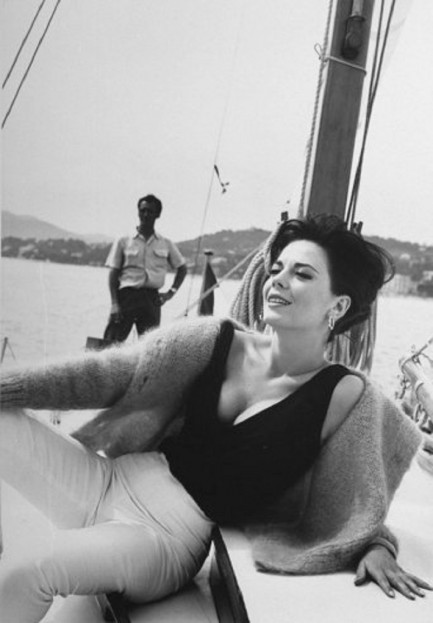 Natalie Wood aboard a sailboat in 1962. Natalie Wood aboard a sailboat in 1962.
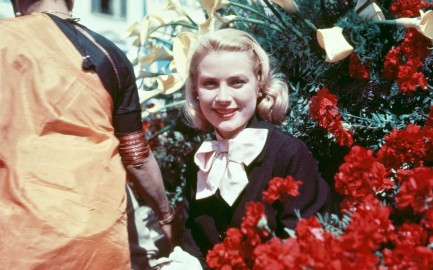 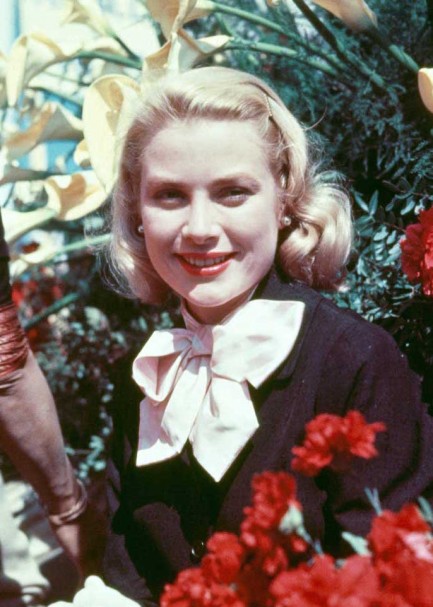 Grace Kelly, 1955. Grace Kelly, 1955.
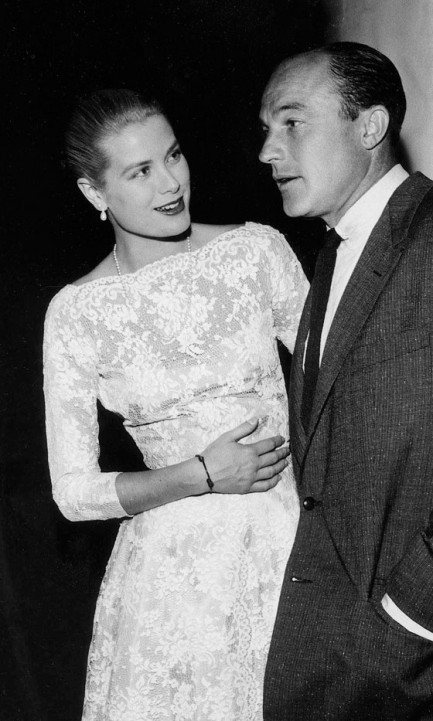 Kelly times two—Grace Kelly and Gene Kelly, hanging out, also in 1955. Kelly times two—Grace Kelly and Gene Kelly, hanging out, also in 1955.
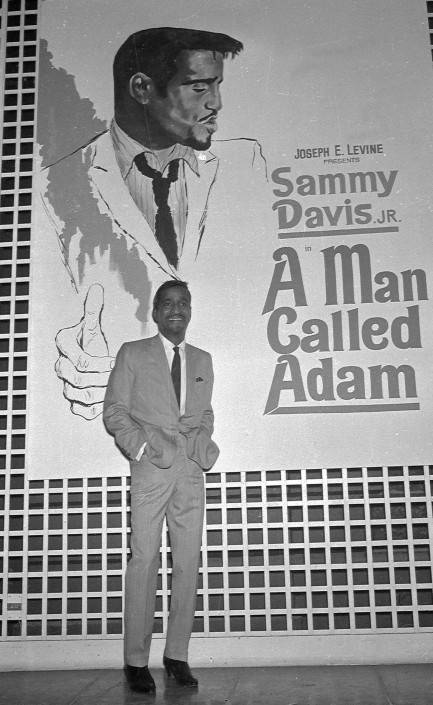 Sammy Davis, Jr. poses in front of a billboard promoting his film A Man Called Adam, 1966. Sammy Davis, Jr. poses in front of a billboard promoting his film A Man Called Adam, 1966. 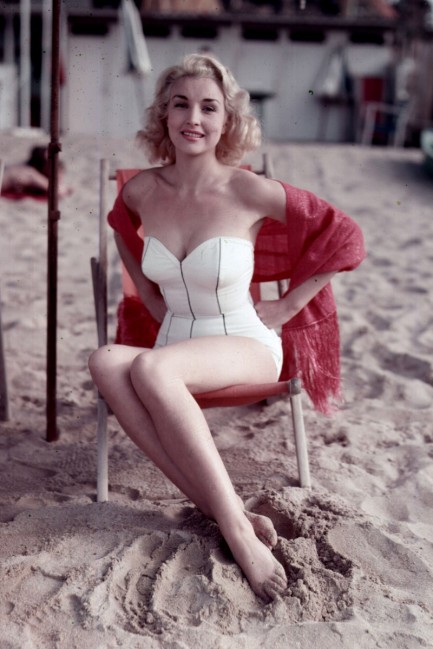 Joan Scott gets sand between her toes in 1955. Scott is obscure. She isn't even the most famous Joan Scott anymore. The IMDB entry for the only Joan Scott near the appropriate age is for an actress born in 1920 who didn't begin acting until 1967. The Joan Scott above doesn't look thirty-five, though, and we doubt she would have been the subject of this somewhat well-known photo without parlaying it into a film appearance before twelve years had passed. So we don't think this is the Joan Scott referenced on IMDB. Joan Scott gets sand between her toes in 1955. Scott is obscure. She isn't even the most famous Joan Scott anymore. The IMDB entry for the only Joan Scott near the appropriate age is for an actress born in 1920 who didn't begin acting until 1967. The Joan Scott above doesn't look thirty-five, though, and we doubt she would have been the subject of this somewhat well-known photo without parlaying it into a film appearance before twelve years had passed. So we don't think this is the Joan Scott referenced on IMDB.  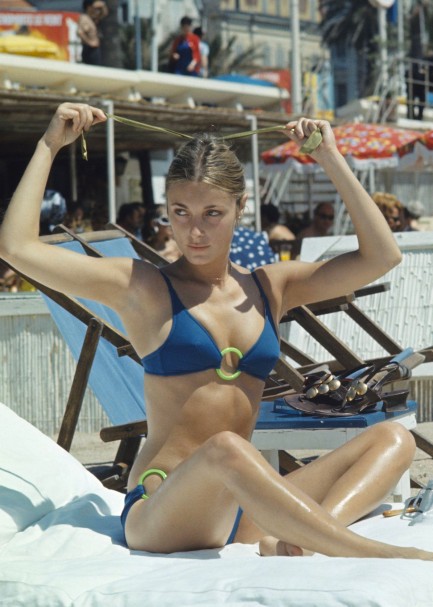 Sharon Tate, with Roman Polanski, and solo, 1968. Sharon Tate, with Roman Polanski, and solo, 1968.
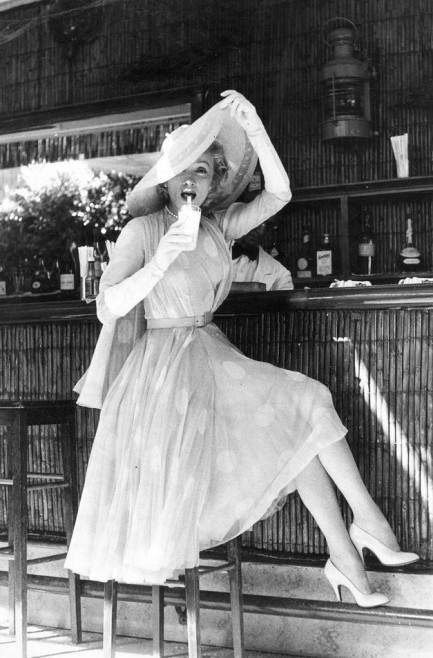 Marlene Dietrich brings glamour to a tiki themed bar in 1958. Marlene Dietrich brings glamour to a tiki themed bar in 1958.
 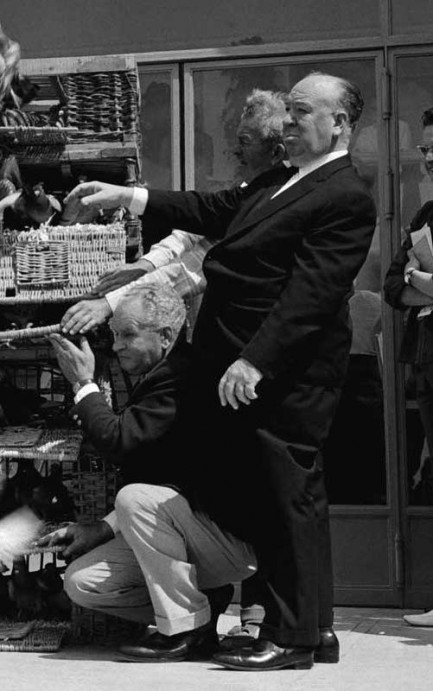 Tippi Hedren and Alfred Hitchcock release caged birds as a promo stunt for The Birds in 1963. Tippi Hedren and Alfred Hitchcock release caged birds as a promo stunt for The Birds in 1963.
 Sophia Loren sits with husband Carlo Ponti, who was a member of the 1966 Festival jury. Sophia Loren sits with husband Carlo Ponti, who was a member of the 1966 Festival jury.
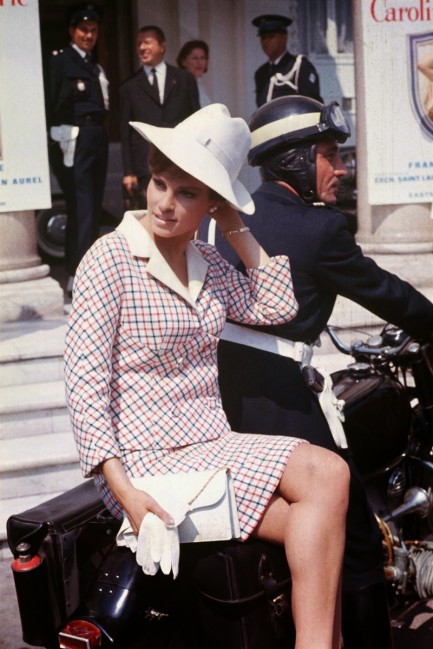 Raquel Welch poses on a motorcycle in 1966. Raquel Welch poses on a motorcycle in 1966.
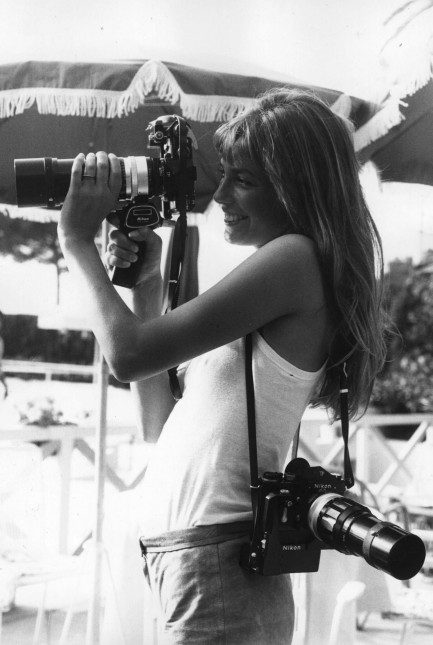 Jane Birkin takes aim with one of her cameras in 1975. Jane Birkin takes aim with one of her cameras in 1975.  Dorothy Dandridge frolics in 1955, when she was promoting her film Carmen Jones. Dorothy Dandridge frolics in 1955, when she was promoting her film Carmen Jones.
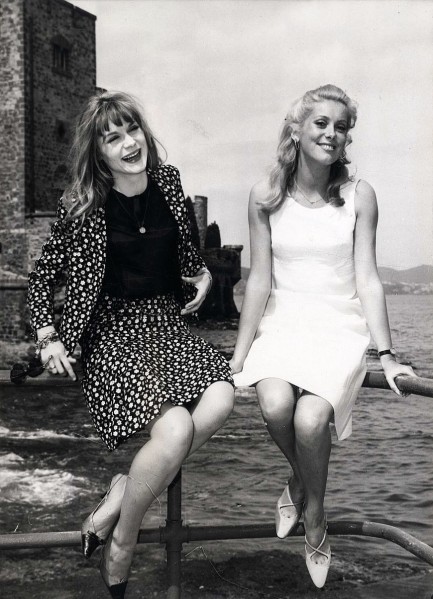 Cinematic icon Catherine Deneuve and her sister Françoise Dorléac in 1965. Dorléac died in an automobile accident a couple of years later. Cinematic icon Catherine Deneuve and her sister Françoise Dorléac in 1965. Dorléac died in an automobile accident a couple of years later. 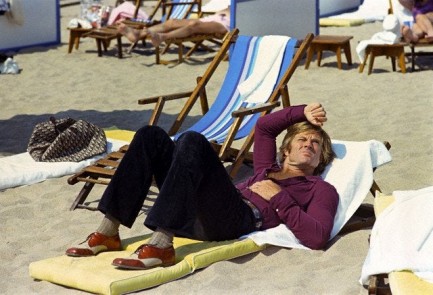 Robert Redford lounges on the beach in 1972. Based on his outfit you'd think he was in Cannes to promote The Sting, but he was actually there for his western Jeremiah Johnson, which screened May 7 of that year. Robert Redford lounges on the beach in 1972. Based on his outfit you'd think he was in Cannes to promote The Sting, but he was actually there for his western Jeremiah Johnson, which screened May 7 of that year.
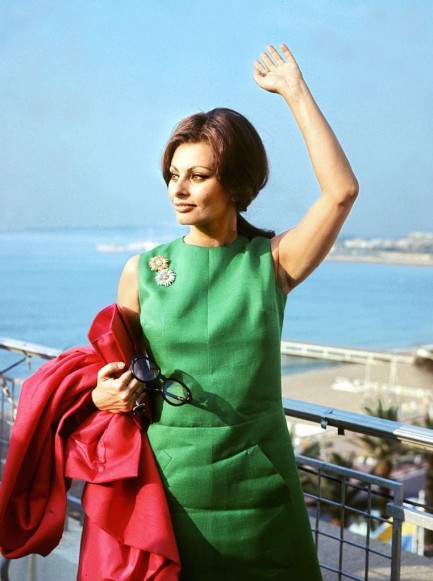 Sophia Loren waves to well-wishers in 1964. Sophia Loren waves to well-wishers in 1964.
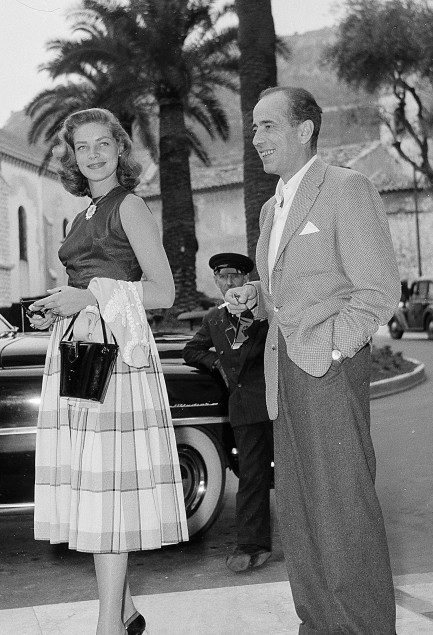 Bogie and Bacall paired up and looking distinguished in 1957. Bogie and Bacall paired up and looking distinguished in 1957.
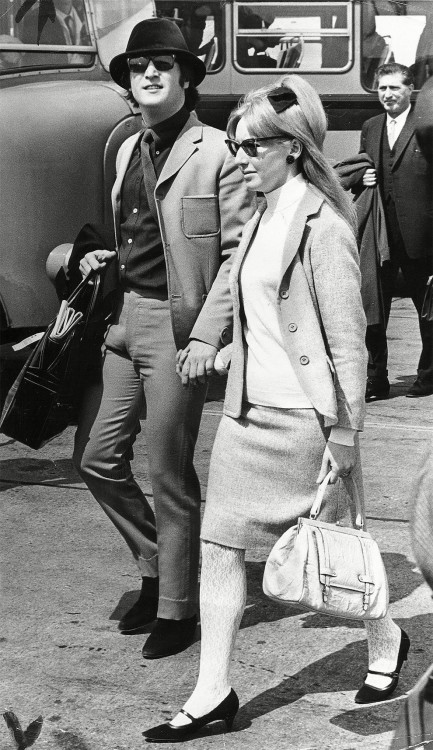 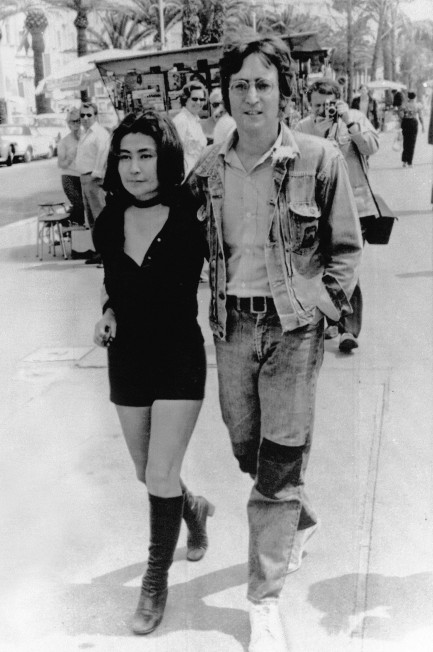 John and Cynthia Lennon in 1965, and John with Yoko Ono in 1971. Every story John told on that second trip probably started with, “When I was here with the first love of my life...” until Yoko smacked him across the mouth. John and Cynthia Lennon in 1965, and John with Yoko Ono in 1971. Every story John told on that second trip probably started with, “When I was here with the first love of my life...” until Yoko smacked him across the mouth.
 Rock Hudson and bicycle in 1966. Rock Hudson and bicycle in 1966.
 Unidentified actresses pose on the beach in 1947. To the rear is the Hotel Carlton, mentioned in the Edith Piaf image, built on the Croisette and finished in 1910. Unidentified actresses pose on the beach in 1947. To the rear is the Hotel Carlton, mentioned in the Edith Piaf image, built on the Croisette and finished in 1910.
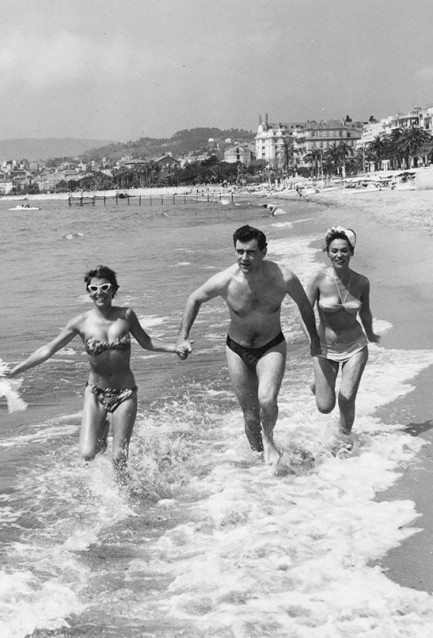 George Baker, Bella Darvi (right—your right, not his), and an unknown acquaintance have a surfside run/photo op in 1956. George Baker, Bella Darvi (right—your right, not his), and an unknown acquaintance have a surfside run/photo op in 1956.
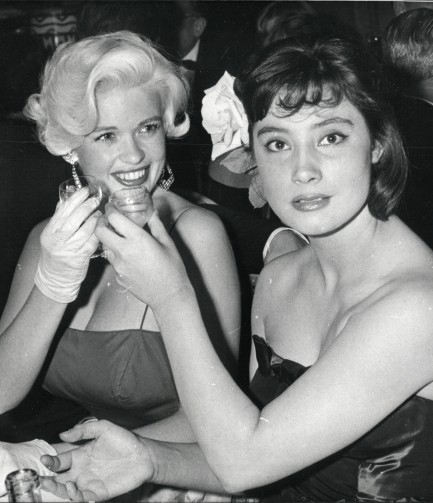 Jayne Mansfield and Russian actress Tatiana Samoïlova enjoy a toast in 1958. Mansfield probably shared the story of how she once made Sophia Loren stare at her boobs, and Samoïlova said, “Cheers to you—well played, you provocative American minx.” Jayne Mansfield and Russian actress Tatiana Samoïlova enjoy a toast in 1958. Mansfield probably shared the story of how she once made Sophia Loren stare at her boobs, and Samoïlova said, “Cheers to you—well played, you provocative American minx.”
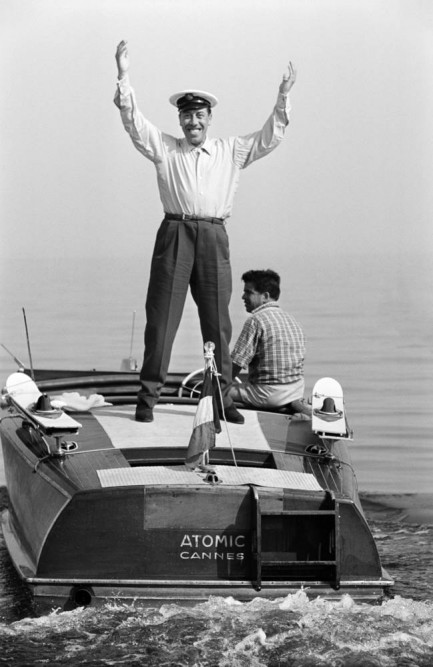 French actor Fernandel, whose real name was Fernand Contandin, on his boat Atomic in 1956. French actor Fernandel, whose real name was Fernand Contandin, on his boat Atomic in 1956.
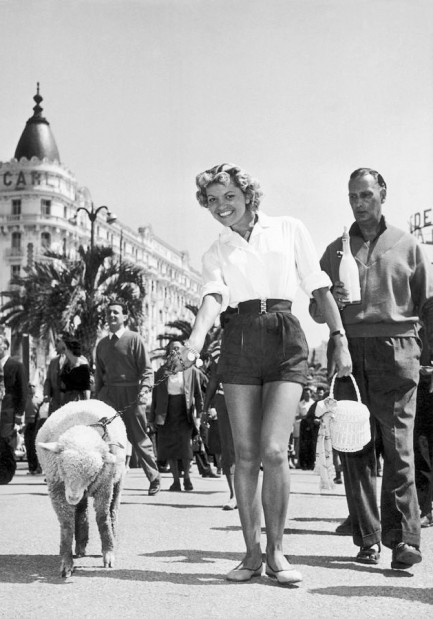 Arlette Patrick figures out a different way to generate publicity—by walking her sheep on the Croisette in 1955. Arlette Patrick figures out a different way to generate publicity—by walking her sheep on the Croisette in 1955.
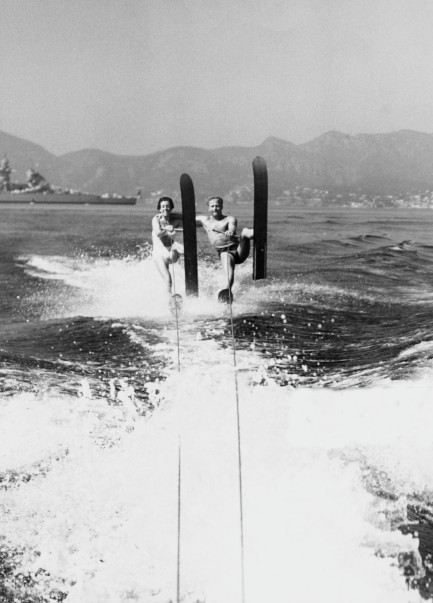 A pair of water skiers show perfect form in 1955, as a battleship floats in the background. A pair of water skiers show perfect form in 1955, as a battleship floats in the background.
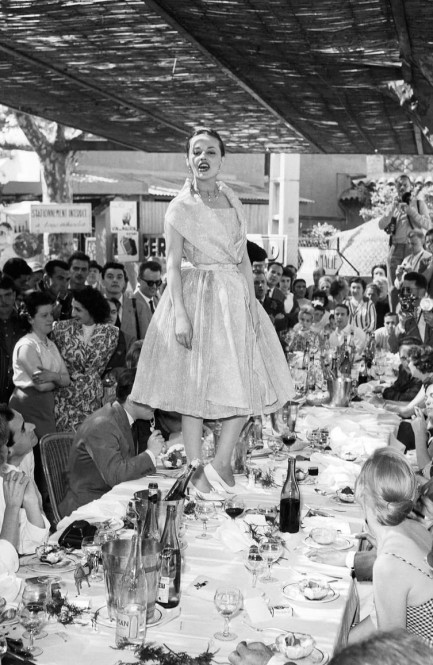 Jeanne Moreau, for reasons that are unclear, poses on a banquet table in 1958. Most sources descibe this in such a way as to make it seem spontaneous, but we have our doubts. It's a great shot, though. Jeanne Moreau, for reasons that are unclear, poses on a banquet table in 1958. Most sources descibe this in such a way as to make it seem spontaneous, but we have our doubts. It's a great shot, though.
 Two unidentified women take in the scene from the terrace of the Hotel Carlton, 1958. This shot is usually said to portray two tourists, but the woman on the left is the same person as in the bikini lunch shot from earlier, which tells us she's a model or actress, and both photos are staged. Like we said, publicity is everything in Cannes. Two unidentified women take in the scene from the terrace of the Hotel Carlton, 1958. This shot is usually said to portray two tourists, but the woman on the left is the same person as in the bikini lunch shot from earlier, which tells us she's a model or actress, and both photos are staged. Like we said, publicity is everything in Cannes. 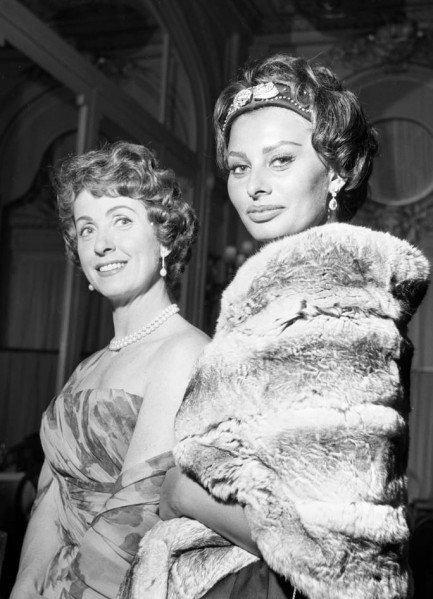  Danielle Darrieux and Sophia Loren at the 11th Cannes Film Festival, 1958. Danielle Darrieux and Sophia Loren at the 11th Cannes Film Festival, 1958.
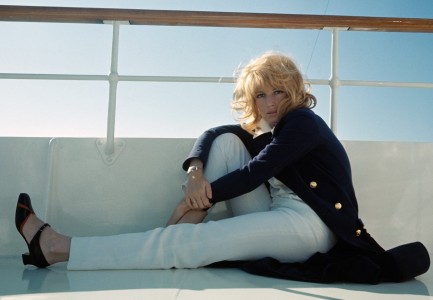 Italian actress Monica Vitti chills on a boat in 1968. Italian actress Monica Vitti chills on a boat in 1968.
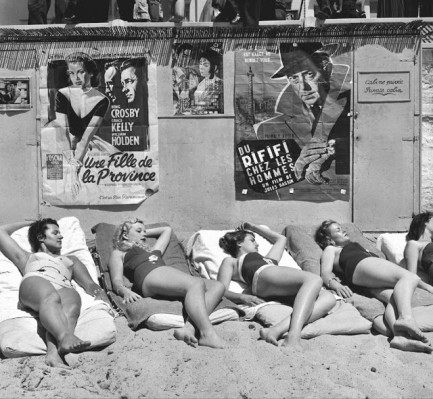 Aspiring stars catch some rays on the Croisette beach in 1955. The two large posters behind them are for The Country Girl with Grace Kelly, and Jules Dassin's Du rififi chez les hommes, both below. Aspiring stars catch some rays on the Croisette beach in 1955. The two large posters behind them are for The Country Girl with Grace Kelly, and Jules Dassin's Du rififi chez les hommes, both below.
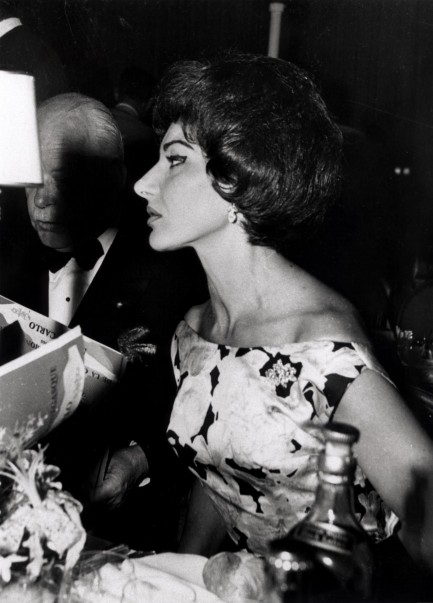 The renowned opera singer Maria Callas, 1960. The renowned opera singer Maria Callas, 1960.

|
 |

The headlines that mattered yesteryear.
2003—Hope Dies
Film legend Bob Hope dies of pneumonia two months after celebrating his 100th birthday. 1945—Churchill Given the Sack
In spite of admiring Winston Churchill as a great wartime leader, Britons elect
Clement Attlee the nation's new prime minister in a sweeping victory for the Labour Party over the Conservatives. 1952—Evita Peron Dies
Eva Duarte de Peron, aka Evita, wife of the president of the Argentine Republic, dies from cancer at age 33. Evita had brought the working classes into a position of political power never witnessed before, but was hated by the nation's powerful military class. She is lain to rest in Milan, Italy in a secret grave under a nun's name, but is eventually returned to Argentina for reburial beside her husband in 1974. 1943—Mussolini Calls It Quits
Italian dictator Benito Mussolini steps down as head of the armed forces and the government. It soon becomes clear that Il Duce did not relinquish power voluntarily, but was forced to resign after former Fascist colleagues turned against him. He is later installed by Germany as leader of the Italian Social Republic in the north of the country, but is killed by partisans in 1945.
|

|
|

It's easy. We have an uploader that makes it a snap. Use it to submit your art, text, header, and subhead. Your post can be funny, serious, or anything in between, as long as it's vintage pulp. You'll get a byline and experience the fleeting pride of free authorship. We'll edit your post for typos, but the rest is up to you. Click here to give us your best shot.

|
|






























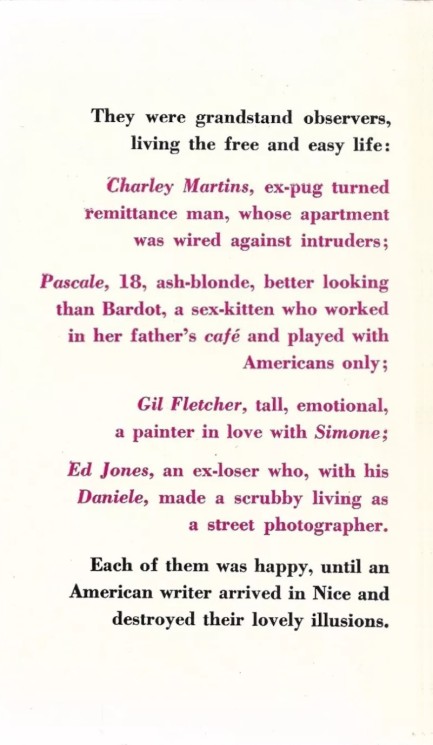
























 In the first photo Lindberg is on the patio of a Cannes bar, and from her perch atop a table she stripped off everything except her panties while dozens of photographer captured her likeness and bystanders gawped at the spectacle. You can see some of assembled press in the fuzzy reverse angle at right. A bit later, on the terrace of the Majestic Hotel where she was staying, her clothes hit the tiles again, as you see below.
In the first photo Lindberg is on the patio of a Cannes bar, and from her perch atop a table she stripped off everything except her panties while dozens of photographer captured her likeness and bystanders gawped at the spectacle. You can see some of assembled press in the fuzzy reverse angle at right. A bit later, on the terrace of the Majestic Hotel where she was staying, her clothes hit the tiles again, as you see below.

































 Fine, Toro, you're huge. Massive. Enormous. But you need to learn how to box or the champ is going to crush your face like a graham cracker.
Fine, Toro, you're huge. Massive. Enormous. But you need to learn how to box or the champ is going to crush your face like a graham cracker. Hi, champ! Before we start, I just want to say I'm probably your biggest admir—
Hi, champ! Before we start, I just want to say I'm probably your biggest admir— I thought that whole graham cracker speech was just Bogie being colorful.
I thought that whole graham cracker speech was just Bogie being colorful.





























 Edith Piaf sings on the terrace of the Carlton Hotel on the iconic Boulevard de la Croisette at the first Festival de Cannes to be held under that name, in 1946. Back then the event took place in September and October, but would shift to May a bit later.
Edith Piaf sings on the terrace of the Carlton Hotel on the iconic Boulevard de la Croisette at the first Festival de Cannes to be held under that name, in 1946. Back then the event took place in September and October, but would shift to May a bit later.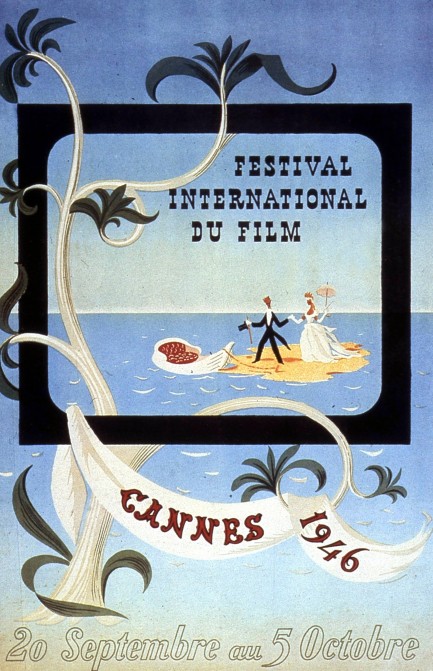
 Diana Dors and Ginger Rogers arrive at the fest the only way anyone should—breezing along the beachfront in a convertible, in 1956, with an unknown driver.
Diana Dors and Ginger Rogers arrive at the fest the only way anyone should—breezing along the beachfront in a convertible, in 1956, with an unknown driver. Kirk Douglas holds court on the beach in 1953, and Brigitte Bardot soaks up rays in the foreground.
Kirk Douglas holds court on the beach in 1953, and Brigitte Bardot soaks up rays in the foreground. Michele Morgan poses at the first Festival in 1946. Photo ops of this sort were essential sources of publicity for stars, and would soon become opportunities for non-stars seeking to be discovered.
Michele Morgan poses at the first Festival in 1946. Photo ops of this sort were essential sources of publicity for stars, and would soon become opportunities for non-stars seeking to be discovered. Case in point. Robert Mitchum poses with actress Simone Sylva in 1954. Sylva was allegedly not supposed to be there, but shucked her top and photo-bombed Douglas in an attempt to raise her profile. It didn't work. She made only a couple of credited movie appearances after her topless stunt.
Case in point. Robert Mitchum poses with actress Simone Sylva in 1954. Sylva was allegedly not supposed to be there, but shucked her top and photo-bombed Douglas in an attempt to raise her profile. It didn't work. She made only a couple of credited movie appearances after her topless stunt. Romy Schneider and Alain Delon at the 1959 fest.
Romy Schneider and Alain Delon at the 1959 fest. An unidentified model or actress poses in the style of Anita Ekberg from La dolce vita in 1960. This looks like it was shot at Plage du Midi, which is a beach located a little ways west of the Cannes town center.
An unidentified model or actress poses in the style of Anita Ekberg from La dolce vita in 1960. This looks like it was shot at Plage du Midi, which is a beach located a little ways west of the Cannes town center. A unidentified partygoer is tossed into a swimming pool after La Dolce Vita won the the 1960 Palme d’Or. The Festival is almost as well known for legendary parties as for legendary film premieres.
A unidentified partygoer is tossed into a swimming pool after La Dolce Vita won the the 1960 Palme d’Or. The Festival is almost as well known for legendary parties as for legendary film premieres.
 Another unidentified model or actress poses on the boardwalk in 1979. Generally, you don't have to be known to draw a crowd of photographers—you just have to be nearly bare. She's wearing lingerie, so that explains the interest, though this is modest garb for a Cannes publicity stunt. It's never a surprise to see a headline-seeking film hopeful strip all the way down to a string ficelle féminin, or thong, which is the limit of what is legal in Cannes
Another unidentified model or actress poses on the boardwalk in 1979. Generally, you don't have to be known to draw a crowd of photographers—you just have to be nearly bare. She's wearing lingerie, so that explains the interest, though this is modest garb for a Cannes publicity stunt. It's never a surprise to see a headline-seeking film hopeful strip all the way down to a string ficelle féminin, or thong, which is the limit of what is legal in Cannes Sidney Poitier and Jean Seberg have a laugh in 1961. This was the year Poitier's flick Paris Blues was released, so it's possible he had jetted down from the capital for the Festival.
Sidney Poitier and Jean Seberg have a laugh in 1961. This was the year Poitier's flick Paris Blues was released, so it's possible he had jetted down from the capital for the Festival. Philomène Toulouse relaxes on the sand in 1962 while a boy practices the classic French look of disgust he'll be using the rest of his life.
Philomène Toulouse relaxes on the sand in 1962 while a boy practices the classic French look of disgust he'll be using the rest of his life. Actor Bernard Blier, 1975.
Actor Bernard Blier, 1975. An unidentified bikini wearer boldly enjoys a lunch in a café on the Croisette, 1958.
An unidentified bikini wearer boldly enjoys a lunch in a café on the Croisette, 1958. Natalie Wood aboard a sailboat in 1962.
Natalie Wood aboard a sailboat in 1962.
 Grace Kelly, 1955.
Grace Kelly, 1955. Kelly times two—Grace Kelly and Gene Kelly, hanging out, also in 1955.
Kelly times two—Grace Kelly and Gene Kelly, hanging out, also in 1955. Sammy Davis, Jr. poses in front of a billboard promoting his film A Man Called Adam, 1966.
Sammy Davis, Jr. poses in front of a billboard promoting his film A Man Called Adam, 1966. Joan Scott gets sand between her toes in 1955. Scott is obscure. She isn't even the most famous Joan Scott anymore. The IMDB entry for the only Joan Scott near the appropriate age is for an actress born in 1920 who didn't begin acting until 1967. The Joan Scott above doesn't look thirty-five, though, and we doubt she would have been the subject of this somewhat well-known photo without parlaying it into a film appearance before twelve years had passed. So we don't think this is the Joan Scott referenced on IMDB.
Joan Scott gets sand between her toes in 1955. Scott is obscure. She isn't even the most famous Joan Scott anymore. The IMDB entry for the only Joan Scott near the appropriate age is for an actress born in 1920 who didn't begin acting until 1967. The Joan Scott above doesn't look thirty-five, though, and we doubt she would have been the subject of this somewhat well-known photo without parlaying it into a film appearance before twelve years had passed. So we don't think this is the Joan Scott referenced on IMDB.
 Sharon Tate, with Roman Polanski, and solo, 1968.
Sharon Tate, with Roman Polanski, and solo, 1968. Marlene Dietrich brings glamour to a tiki themed bar in 1958.
Marlene Dietrich brings glamour to a tiki themed bar in 1958.
 Tippi Hedren and Alfred Hitchcock release caged birds as a promo stunt for The Birds in 1963.
Tippi Hedren and Alfred Hitchcock release caged birds as a promo stunt for The Birds in 1963. Sophia Loren sits with husband Carlo Ponti, who was a member of the 1966 Festival jury.
Sophia Loren sits with husband Carlo Ponti, who was a member of the 1966 Festival jury. Raquel Welch poses on a motorcycle in 1966.
Raquel Welch poses on a motorcycle in 1966. Jane Birkin takes aim with one of her cameras in 1975.
Jane Birkin takes aim with one of her cameras in 1975. Dorothy Dandridge frolics in 1955, when she was promoting her film Carmen Jones.
Dorothy Dandridge frolics in 1955, when she was promoting her film Carmen Jones. Cinematic icon Catherine Deneuve and her sister Françoise Dorléac in 1965. Dorléac died in an automobile accident a couple of years later.
Cinematic icon Catherine Deneuve and her sister Françoise Dorléac in 1965. Dorléac died in an automobile accident a couple of years later. Robert Redford lounges on the beach in 1972. Based on his outfit you'd think he was in Cannes to promote The Sting, but he was actually there for his western Jeremiah Johnson, which screened May 7 of that year.
Robert Redford lounges on the beach in 1972. Based on his outfit you'd think he was in Cannes to promote The Sting, but he was actually there for his western Jeremiah Johnson, which screened May 7 of that year. Sophia Loren waves to well-wishers in 1964.
Sophia Loren waves to well-wishers in 1964. Bogie and Bacall paired up and looking distinguished in 1957.
Bogie and Bacall paired up and looking distinguished in 1957.
 John and Cynthia Lennon in 1965, and John with Yoko Ono in 1971. Every story John told on that second trip probably started with, “When I was here with the first love of my life...” until Yoko smacked him across the mouth.
John and Cynthia Lennon in 1965, and John with Yoko Ono in 1971. Every story John told on that second trip probably started with, “When I was here with the first love of my life...” until Yoko smacked him across the mouth. Rock Hudson and bicycle in 1966.
Rock Hudson and bicycle in 1966. Unidentified actresses pose on the beach in 1947. To the rear is the Hotel Carlton, mentioned in the Edith Piaf image, built on the Croisette and finished in 1910.
Unidentified actresses pose on the beach in 1947. To the rear is the Hotel Carlton, mentioned in the Edith Piaf image, built on the Croisette and finished in 1910. George Baker, Bella Darvi (right—your right, not his), and an unknown acquaintance have a surfside run/photo op in 1956.
George Baker, Bella Darvi (right—your right, not his), and an unknown acquaintance have a surfside run/photo op in 1956. Jayne Mansfield and Russian actress Tatiana Samoïlova enjoy a toast in 1958. Mansfield probably shared the story of how she once made Sophia Loren stare at her boobs, and Samoïlova said, “Cheers to you—well played, you provocative American minx.”
Jayne Mansfield and Russian actress Tatiana Samoïlova enjoy a toast in 1958. Mansfield probably shared the story of how she once made Sophia Loren stare at her boobs, and Samoïlova said, “Cheers to you—well played, you provocative American minx.” French actor Fernandel, whose real name was Fernand Contandin, on his boat Atomic in 1956.
French actor Fernandel, whose real name was Fernand Contandin, on his boat Atomic in 1956. Arlette Patrick figures out a different way to generate publicity—by walking her sheep on the Croisette in 1955.
Arlette Patrick figures out a different way to generate publicity—by walking her sheep on the Croisette in 1955. A pair of water skiers show perfect form in 1955, as a battleship floats in the background.
A pair of water skiers show perfect form in 1955, as a battleship floats in the background. Jeanne Moreau, for reasons that are unclear, poses on a banquet table in 1958. Most sources descibe this in such a way as to make it seem spontaneous, but we have our doubts. It's a great shot, though.
Jeanne Moreau, for reasons that are unclear, poses on a banquet table in 1958. Most sources descibe this in such a way as to make it seem spontaneous, but we have our doubts. It's a great shot, though. Two unidentified women take in the scene from the terrace of the Hotel Carlton, 1958. This shot is usually said to portray two tourists, but the woman on the left is the same person as in the bikini lunch shot from earlier, which tells us she's a model or actress, and both photos are staged. Like we said, publicity is everything in Cannes.
Two unidentified women take in the scene from the terrace of the Hotel Carlton, 1958. This shot is usually said to portray two tourists, but the woman on the left is the same person as in the bikini lunch shot from earlier, which tells us she's a model or actress, and both photos are staged. Like we said, publicity is everything in Cannes.
 Danielle Darrieux and Sophia Loren at the 11th Cannes Film Festival, 1958.
Danielle Darrieux and Sophia Loren at the 11th Cannes Film Festival, 1958. Italian actress Monica Vitti chills on a boat in 1968.
Italian actress Monica Vitti chills on a boat in 1968. Aspiring stars catch some rays on the Croisette beach in 1955. The two large posters behind them are for The Country Girl with Grace Kelly, and Jules Dassin's Du rififi chez les hommes, both below.
Aspiring stars catch some rays on the Croisette beach in 1955. The two large posters behind them are for The Country Girl with Grace Kelly, and Jules Dassin's Du rififi chez les hommes, both below.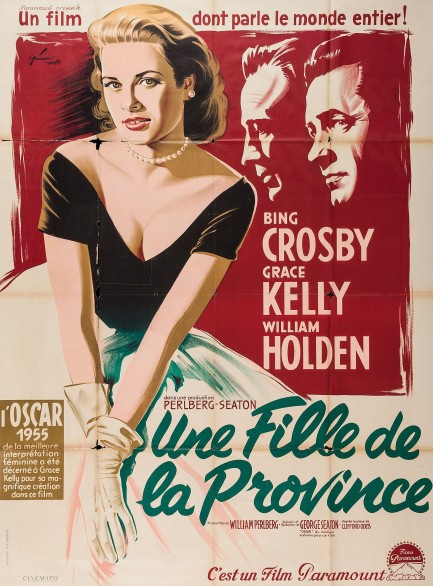
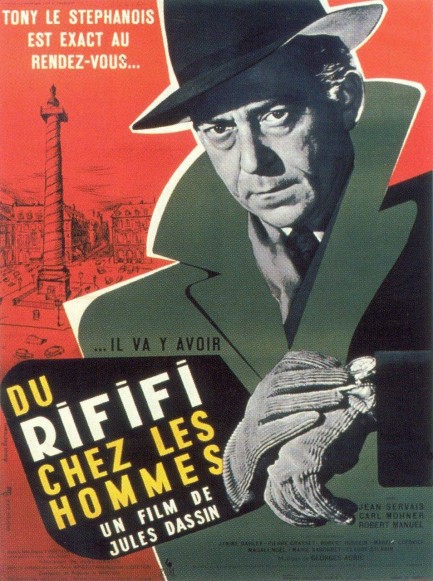
 The renowned opera singer Maria Callas, 1960.
The renowned opera singer Maria Callas, 1960.




































































